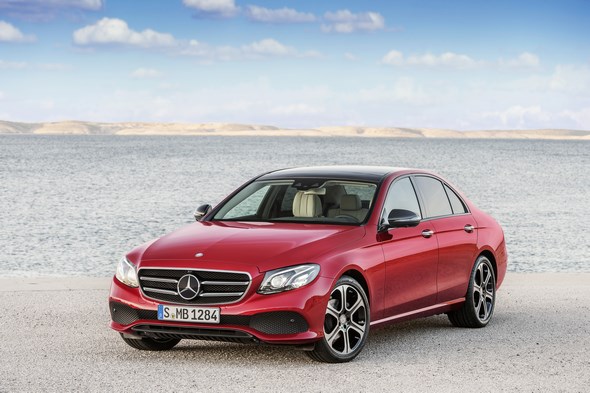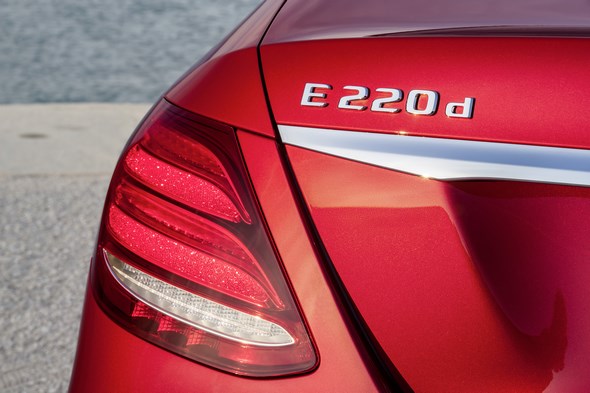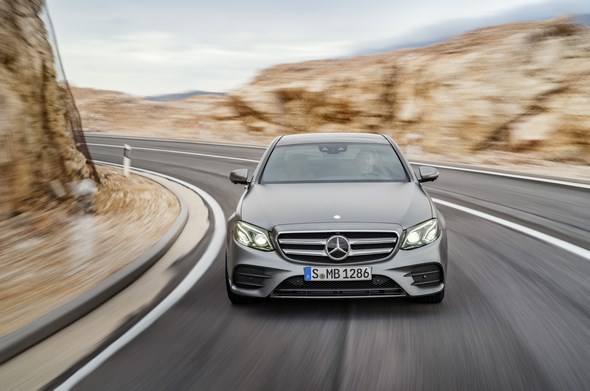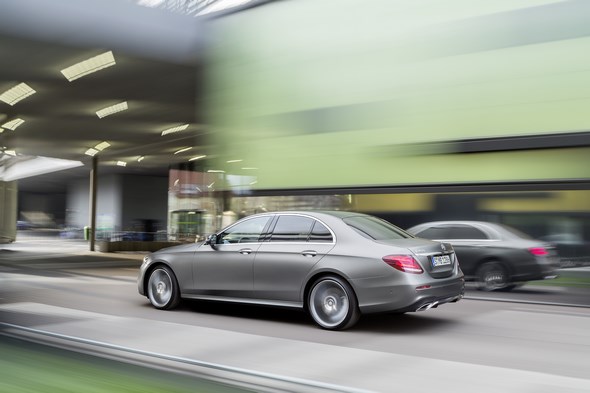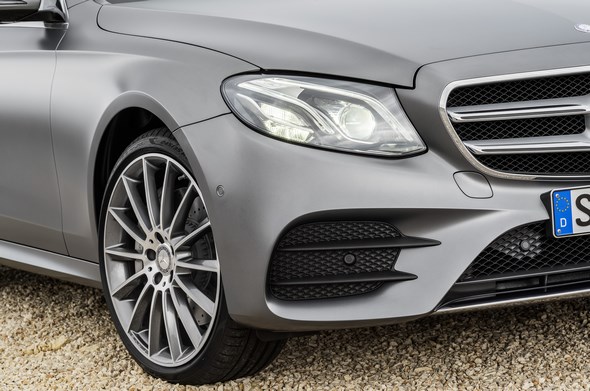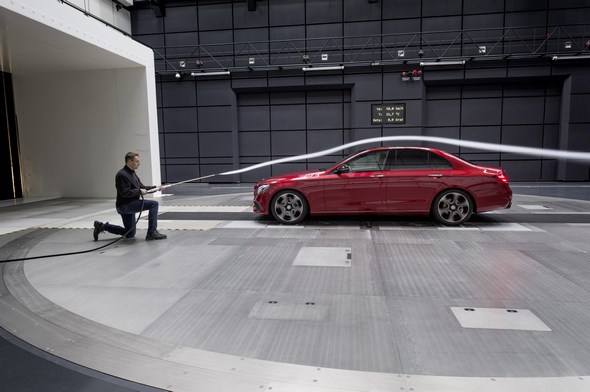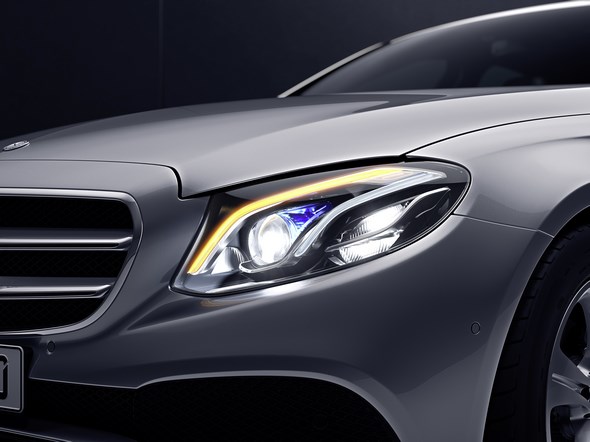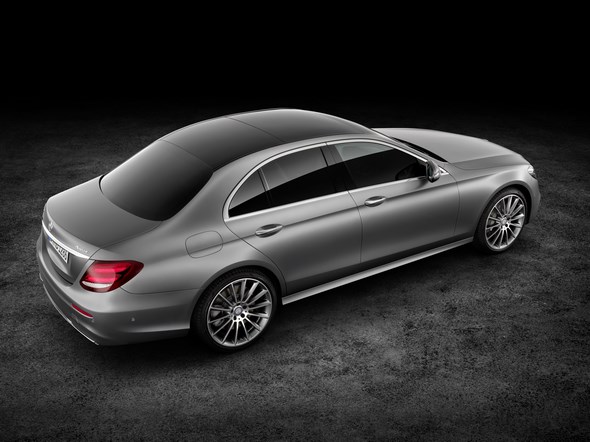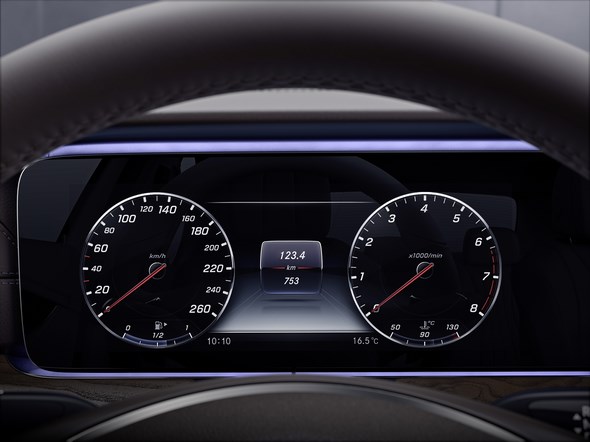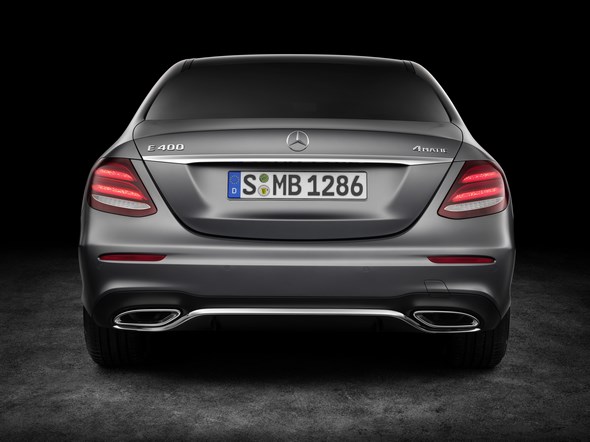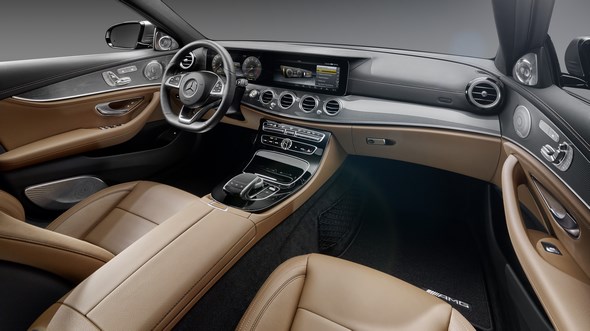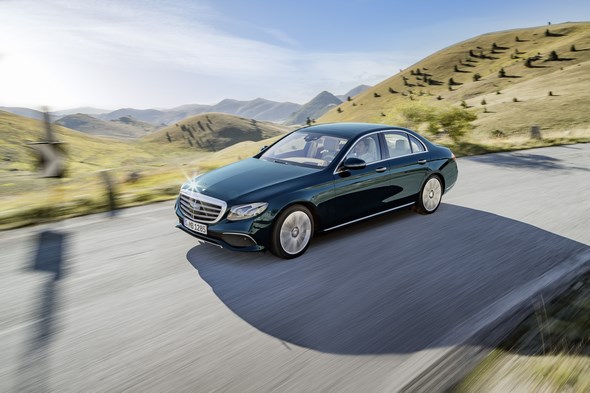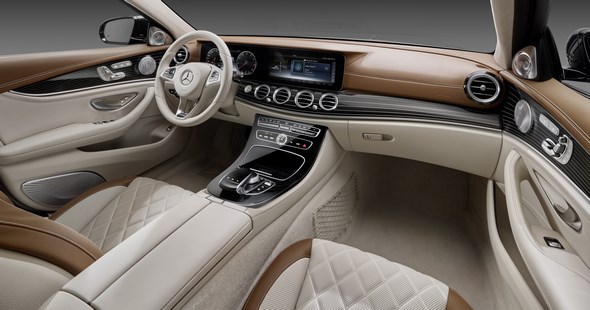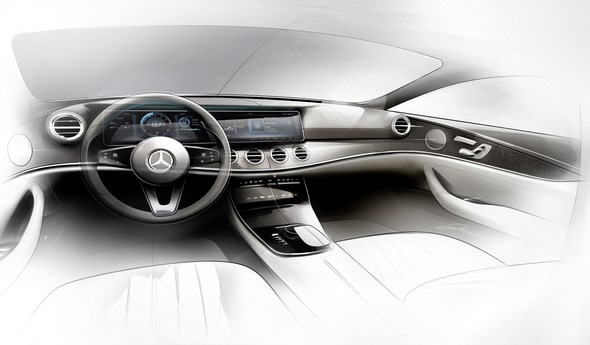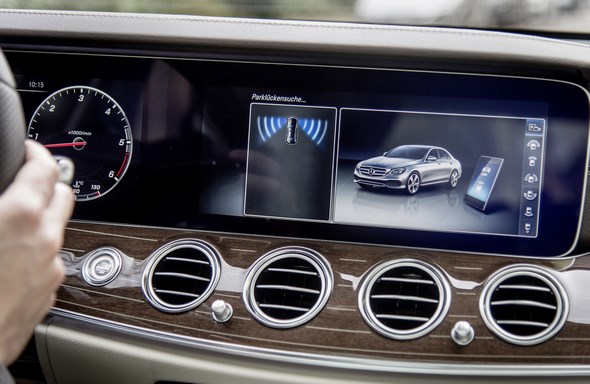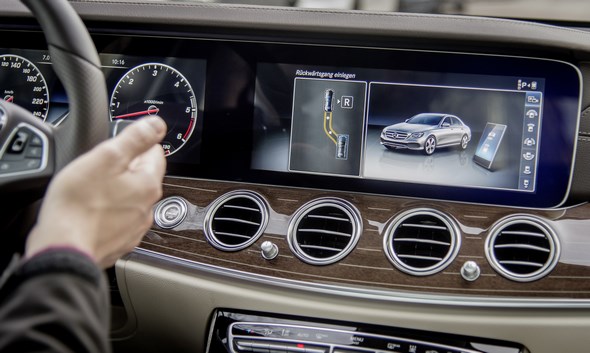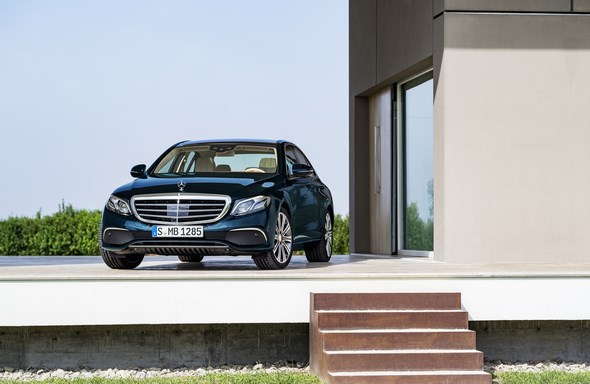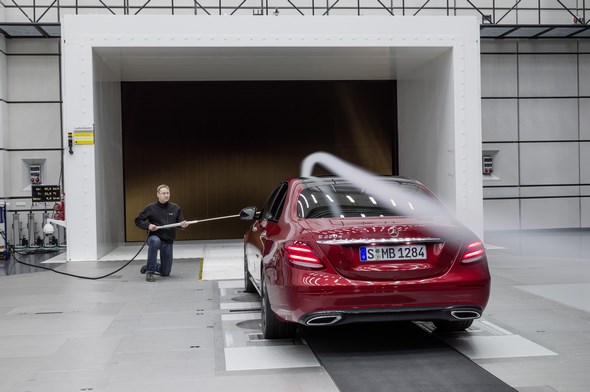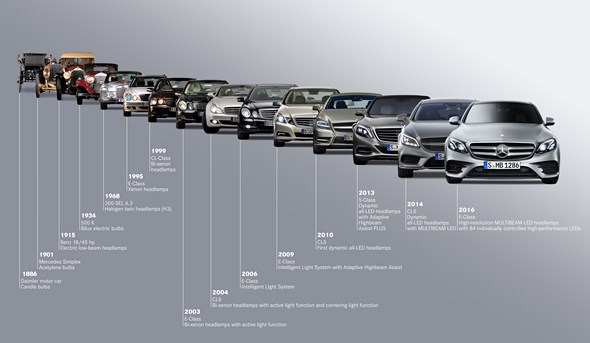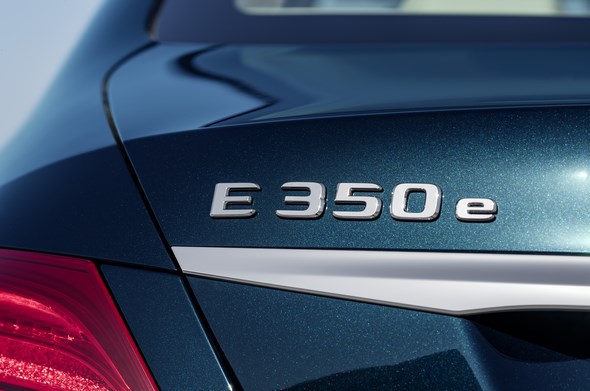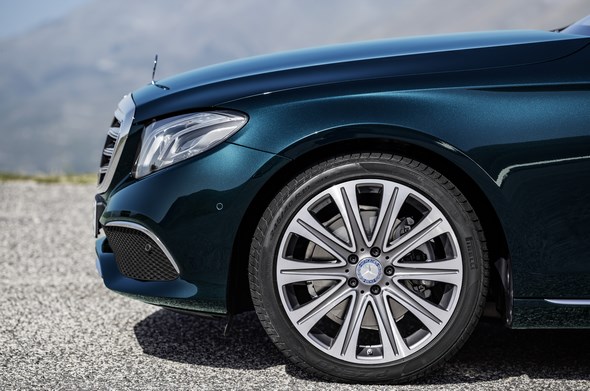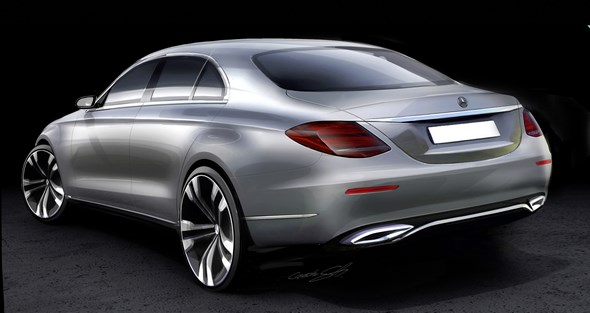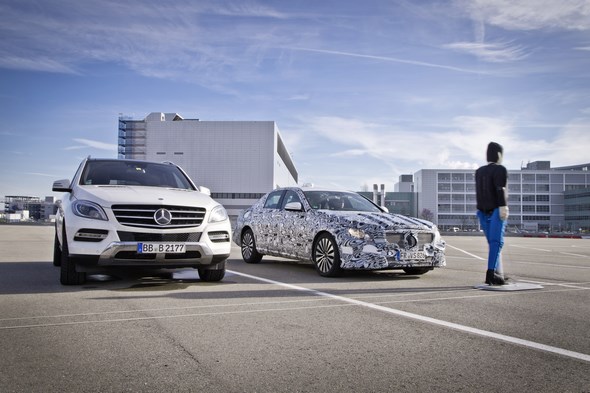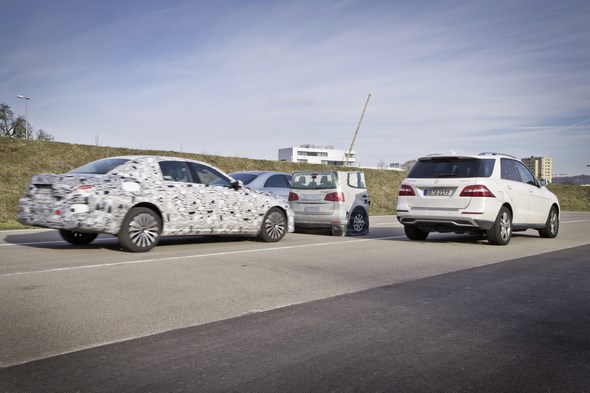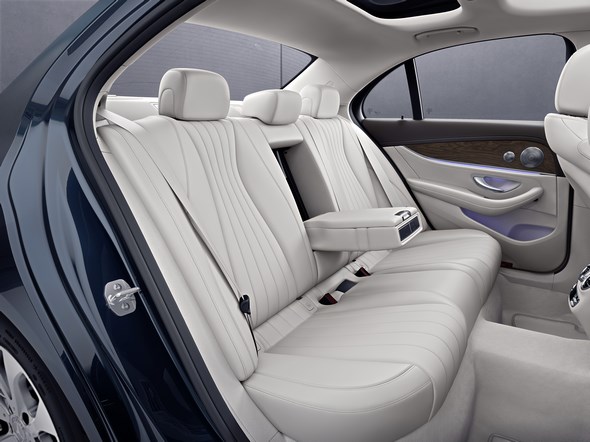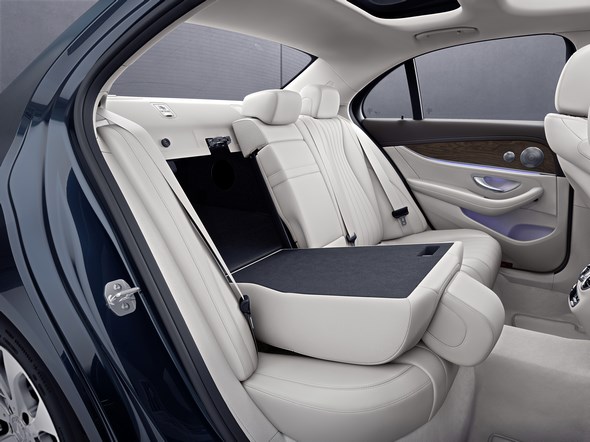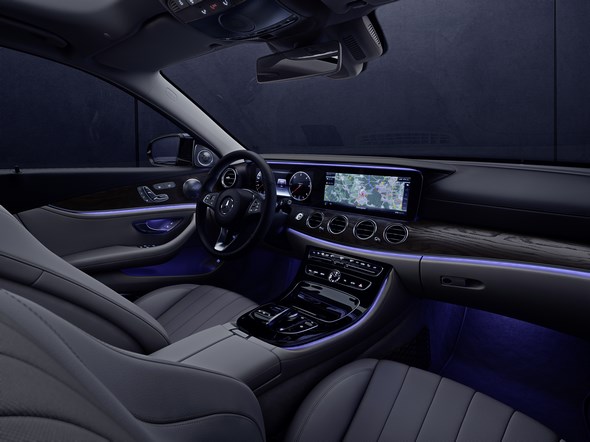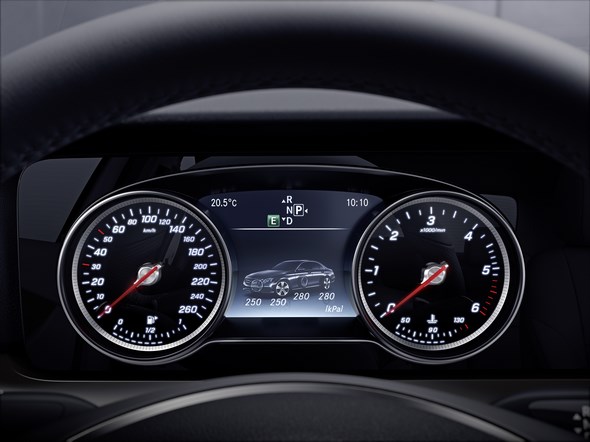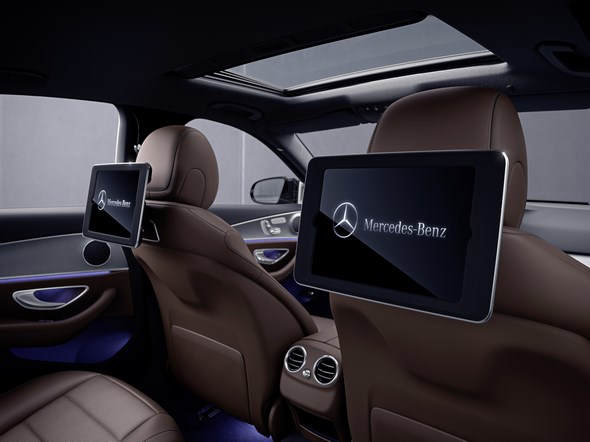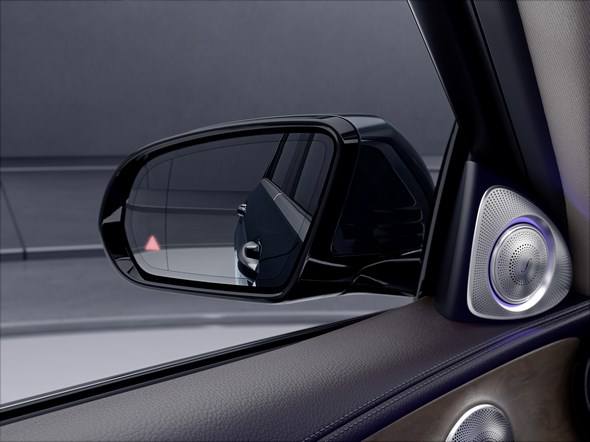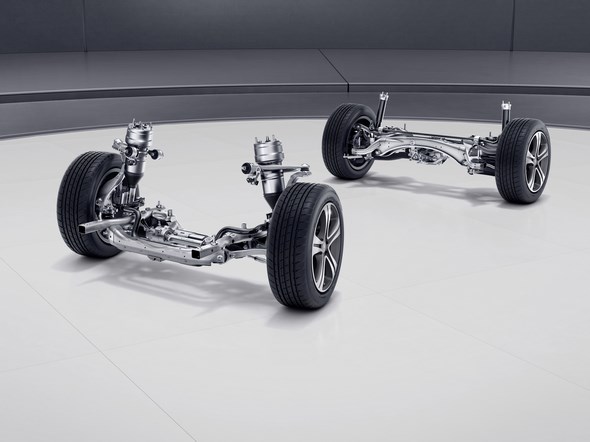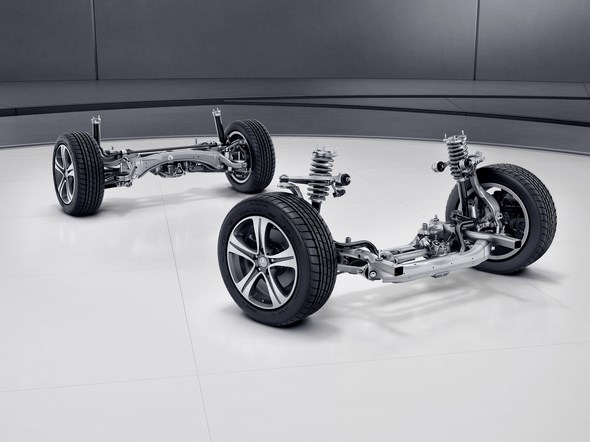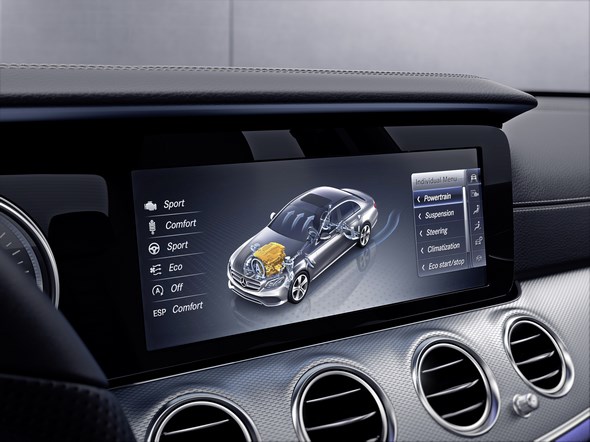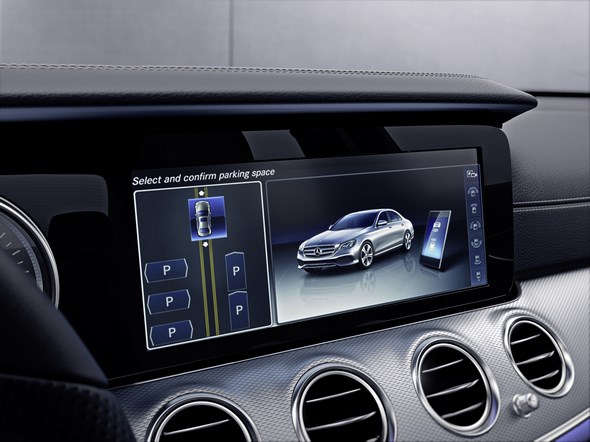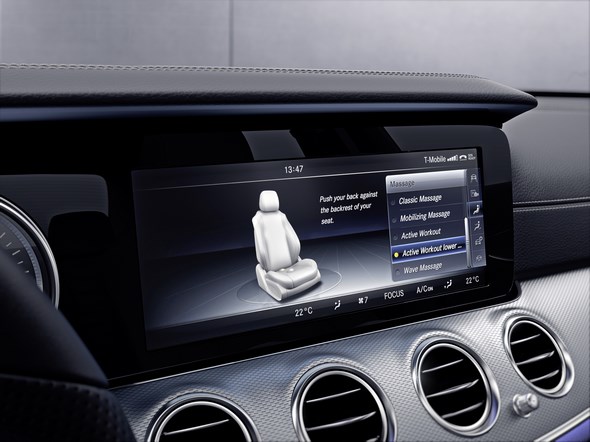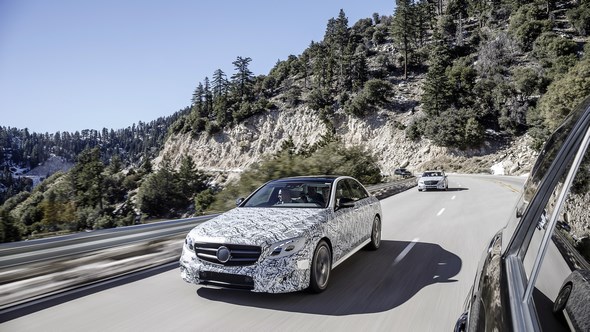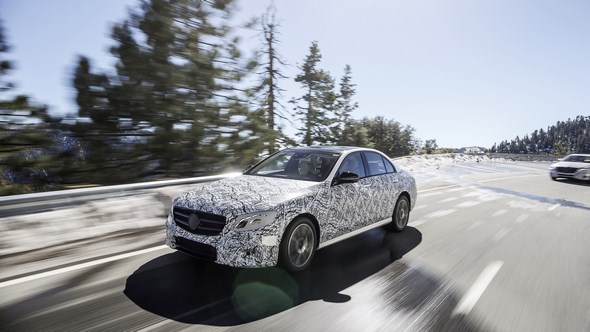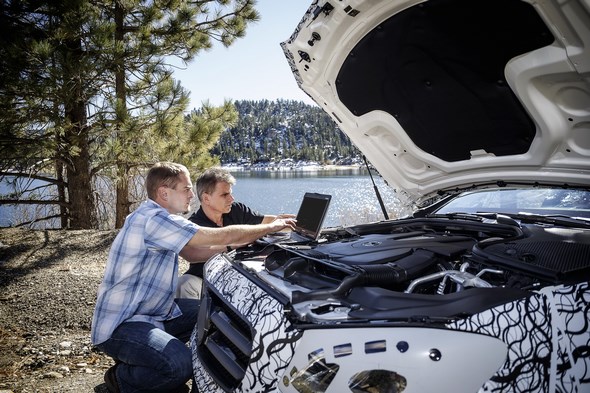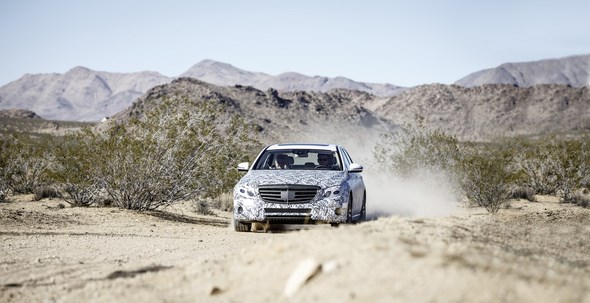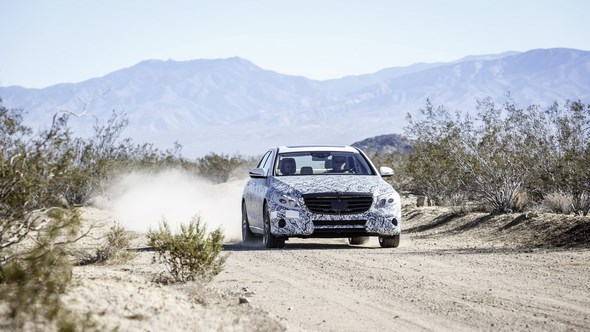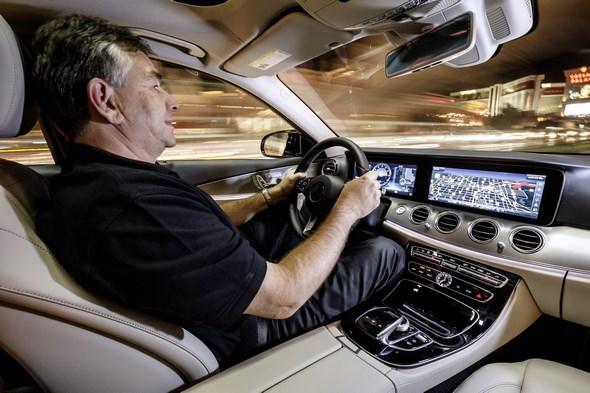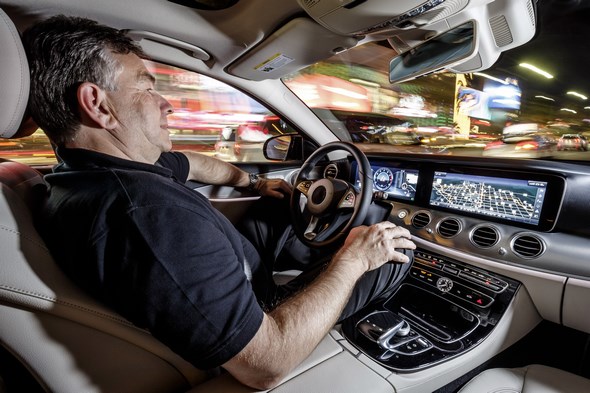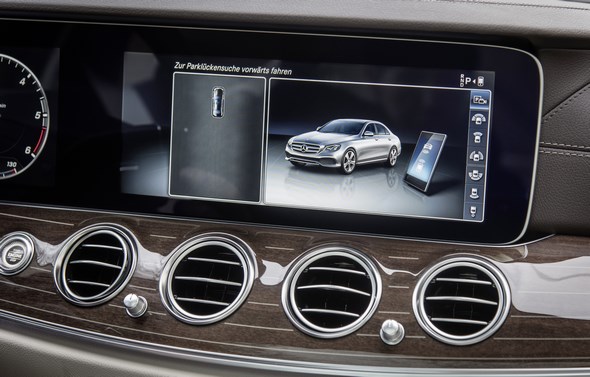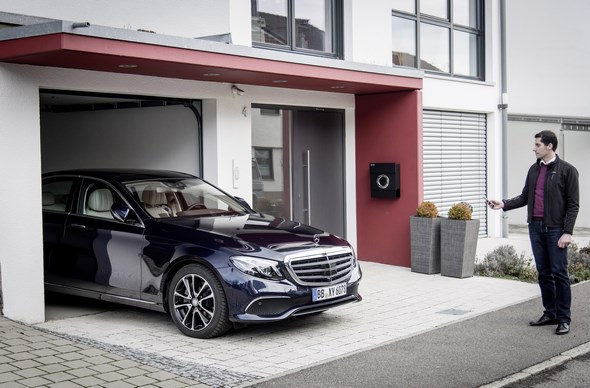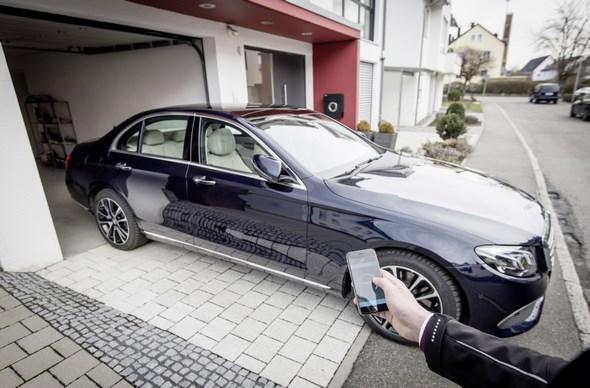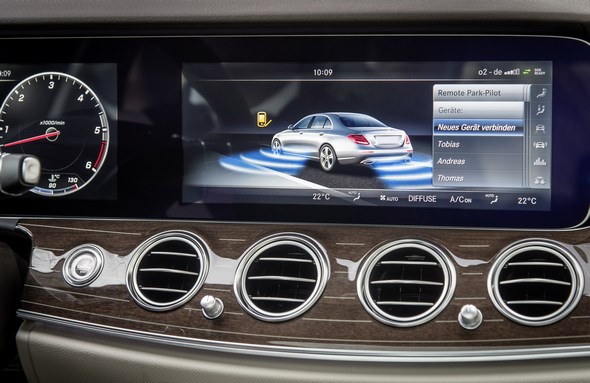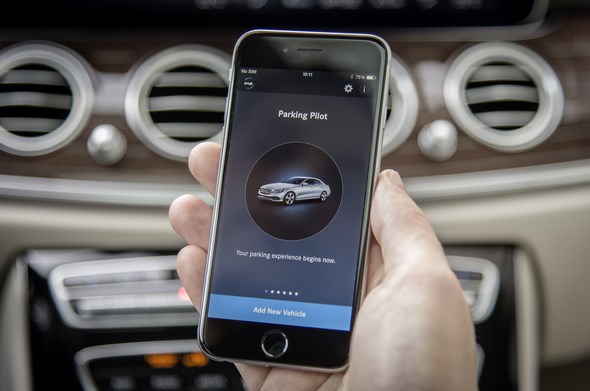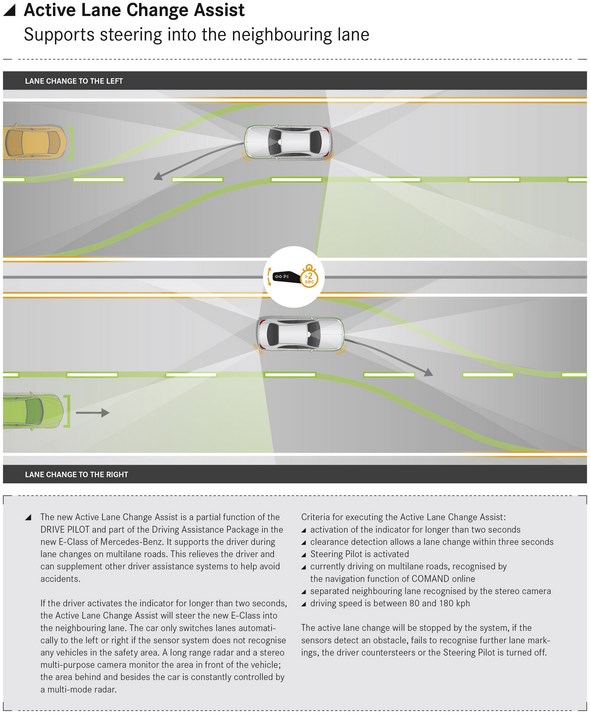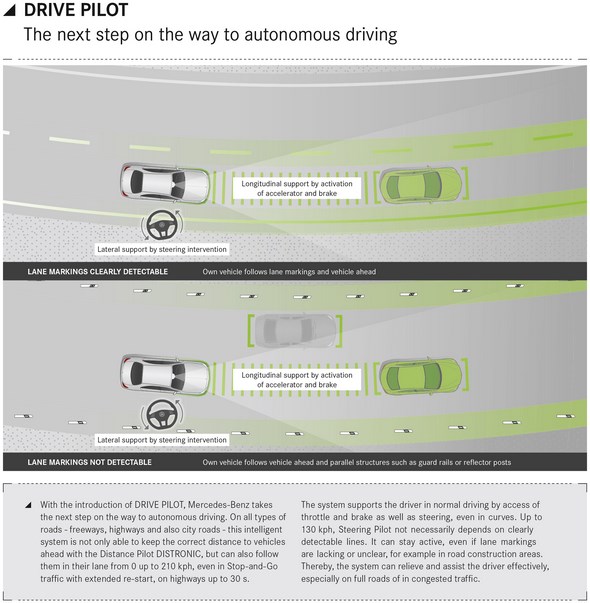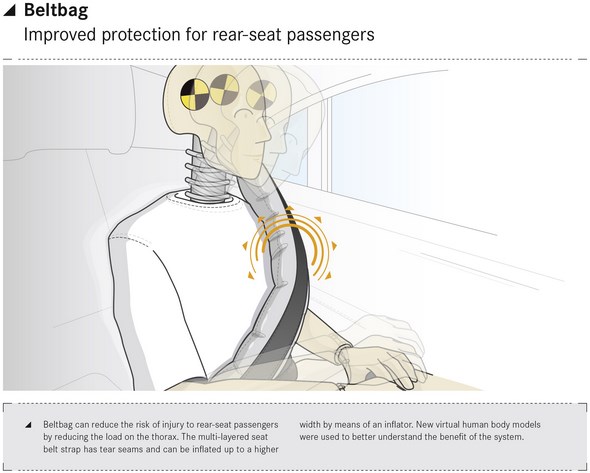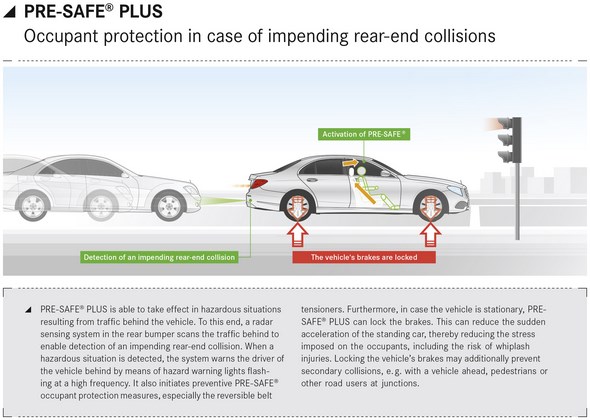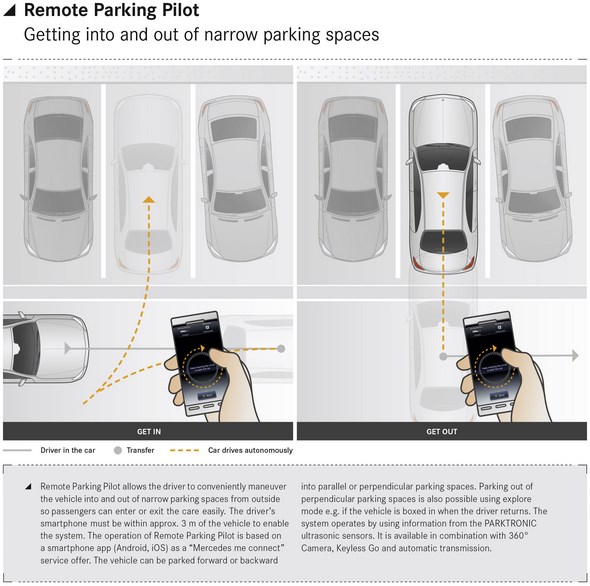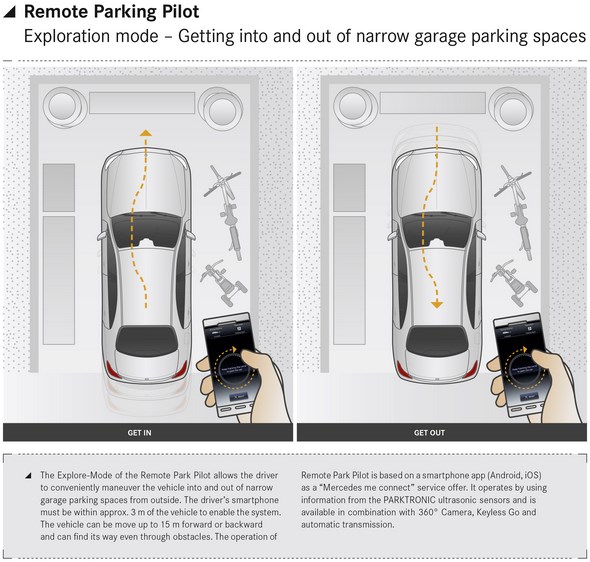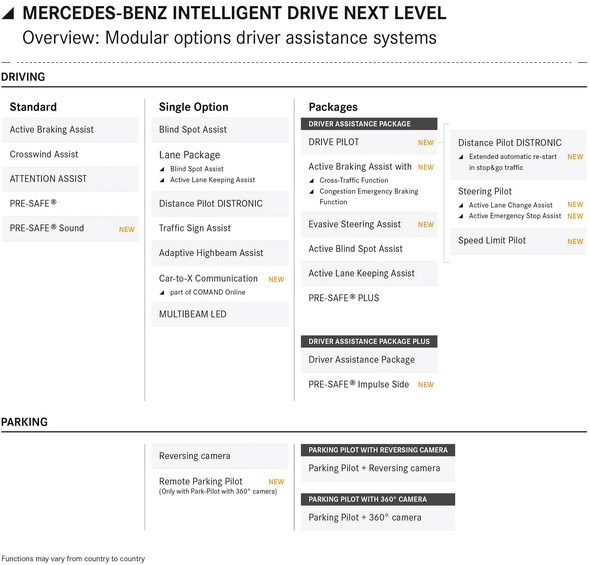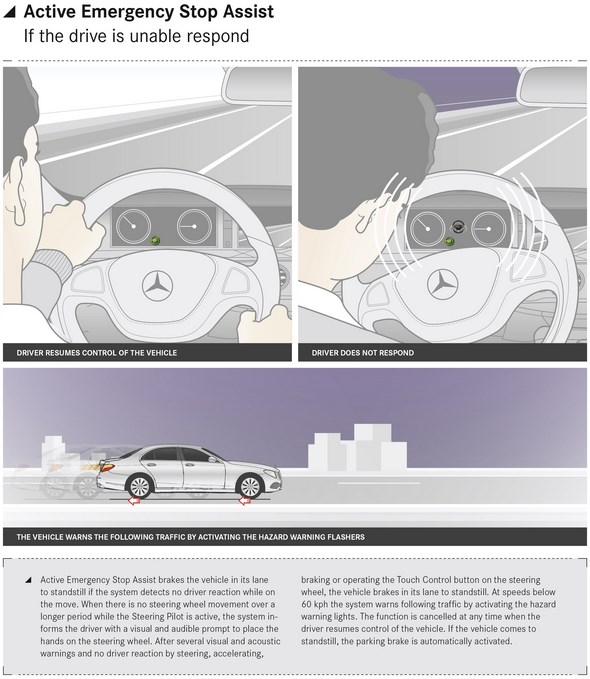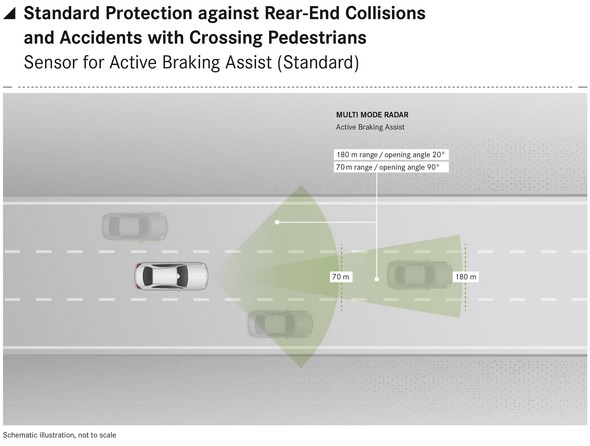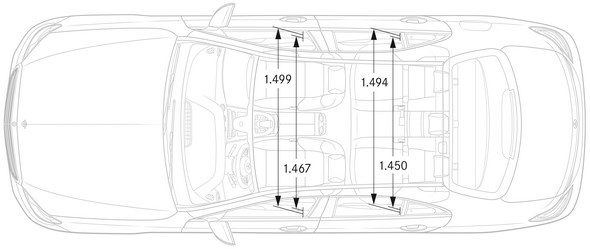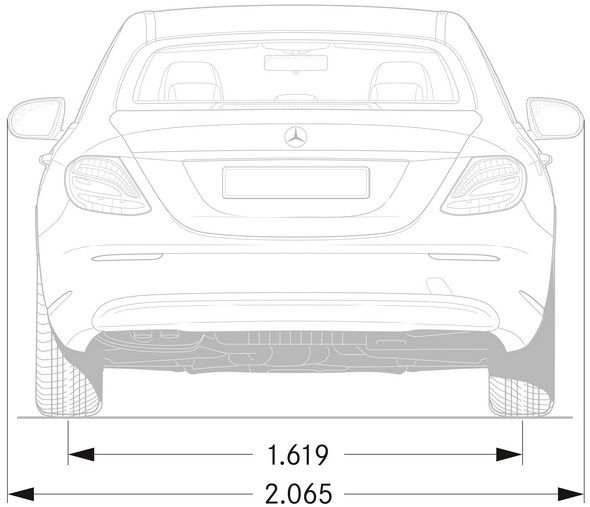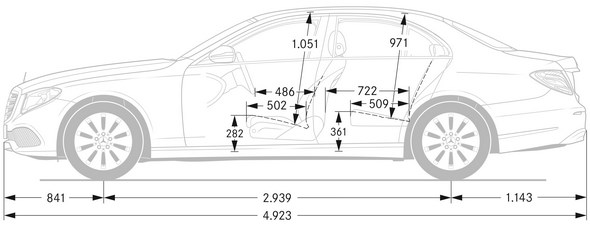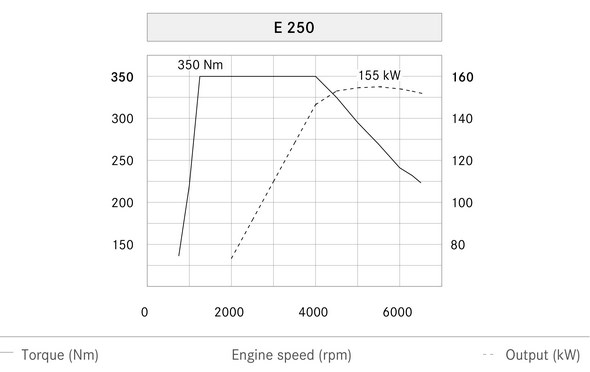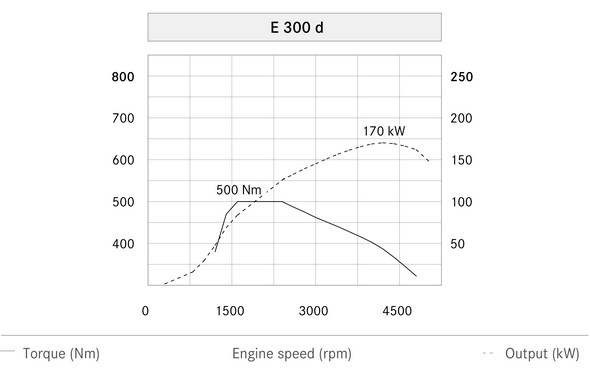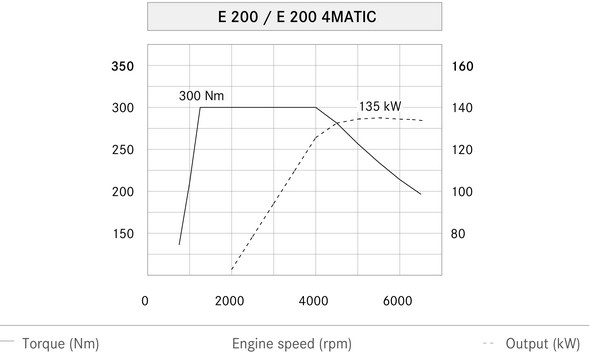Mercedes W213 E-Class 2017-

The new E-Class
The most intelligent executive saloon
Stuttgart. Mercedes-Benz is taking a big step into the future with the new E‑Class. The tenth-generation executive saloon delivers stylish highlights with its distinct, emotive design and high-grade, exclusive interior.
This new E‑Class also marks the world premiere of numerous technical innovations. They enable comfortable, safe driving on a new level plus a new dimension in driver assistance – among other things.
The vehicle comes complete with infotainment and control systems offering an all-new experience. Likewise exemplary: an entirely newly developed diesel engine sets efficiency benchmarks in this segment in conjunction with lightweight construction and optimum aerodynamic figures.
An optional new multi-chamber air suspension system additionally ensures outstanding ride comfort together with first-class driving dynamics.
The sum total of its innovations, including the Active Lane-change Assistant which allows the driver to effortlessly steer into the selected lane, makes the E-Class the most intelligent saloon in the executive class.
It can be ordered at prices starting from 45,303.30 euros. This means that, for a comparable equipment specification, the prices are only slightly higher than those of the corresponding previous models.
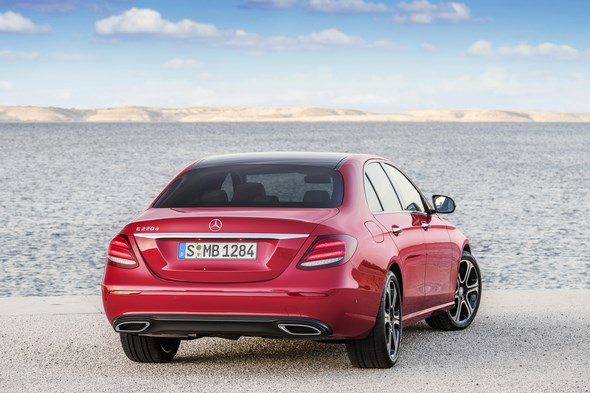
The new E-Class will be in dealer showrooms from April 2016.
The new E-Class is sophisticated, confidently stylish and dynamic. Compared with its predecessor, its wheelbase length has grown by 65 millimetres (2939/2874), its overall length by 43 millimetres (4923/4880).
The resulting increase in space is to the benefit of all passengers. The basis for agile handling characteristics is provided by an increased track width (extra 20 millimetres at the front, extra 7 millimetres at the rear).
With minor exceptions, the boot capacity has been maintained at the excellent level of the previous model.
Comparison of measurements
| New E-Class | Predecessor | Difference | |
| Exterior | |||
| Vehicle length mm | 4923 | 4880 | +43 |
| Vehicle width mm | 1852 | 1854 | -2 |
| Vehicle height mm | 1468 | 1471 | -3 |
| Wheelbase mm | 2939 | 2874 | +65 |
| Track width, front mm | 1620 | 1600 | +20 |
| Track width, rear mm | 1626 | 1619 | +7 |
| Interior | |||
| Kneeroom, rear mm | 75 | 69 | +6 |
| Front/rear shoulder room mm | 1467/1450 | 1467/1446 | 0/+4 |
| Boot capacity l | 530 | 540 | -10 |
The design of the new E-Class is characterised by hallmark Mercedes saloon proportions. The elongated bonnet coupled with a coupé-esque roof flowing into a sensual, broad-shouldered tail end creates an exciting silhouette.
The powerfully extended vehicle body of the new E-Class is characterised by short overhangs, a long wheelbase, large wheels and taut well-defined flanks displaying a fresh, stylish and dynamic interpretation of the feature line.
It thus systematically embodies the Mercedes-Benz design philosophy of “sensual purity”.
The new E-Class clearly shows a muscular front end that boasts a different look for each design and equipment line.
The base version features the classic Mercedes radiator grille with the star on the bonnet, as does the EXCLUSIVE line – albeit in an even more elaborate fashion.
The AVANTGARDE and AMG Line models are identifiable by the sports radiator grille with a large Mercedes star as its centrepiece.
Each of the radiator grille designs lends the E-Class a distinct character – elegant and with an emphasis on status or dynamically elegant – offering a unique degree of diversity that makes each different model stand out.
At the rear end, broad shoulders above the rear wheel arches lend the E-Class its unmistakably powerful character.
Single-piece tail lights featuring a two-bar design framed by the vehicle body clearly identify the E-Class as a new member of the Mercedes saloon family.
Optionally, the tail lights provide an additional highlight reminiscent of stardust, the Milky Way or the glow of a jet engine.
This “stardust effect” is created by innovative reflector technology with a specially configured surface structure for the tail lights and is making its debut appearance in the new E-Class.
Next Level Interior Design
The interior of the new E-Class embodies the synthesis of emotion and intelligence. Optional extras include two brilliant next-generation high-resolution displays, each with a wide screen diagonal of 12.3 inches – unique in this segment.
Beneath their shared glass cover, the two displays visually conflate into a wide-screen cockpit that seems to be hovering in thin air, creating a central element that emphasises the horizontal orientation of the interior design.
As the instrument cluster, this wide-screen cockpit contains a large display with virtual instruments in the direct field of vision of the driver as well as a central display above the centre console.
The driver can choose between three different styles to select their preferred look for the wide-screen instrument cluster: “Classic”, “Sport” and “Progressive”.
As the entire cockpit is fully digital, the driver is free to configure the information and views of relevance for them and thus create their own personal cockpit.
In a first for a car, the steering wheel features touch-sensitive Touch Controls. Like a smartphone interface, they respond precisely to horizontal and vertical swiping movements, allowing the driver to control the entire infotainment system using finger swipes without having to take their hands off the steering wheel.
In keeping with the motto “hands on the wheel, eyes on the road“, this allows minimum driver distraction to be achieved.
Further controls for the infotainment system are provided in the shape of a Touchpad with Controller in the centre console, which can even recognise handwriting, and the LINGUATRONIC voice control system.
There are also direct-access buttons for controlling functions such as the air-conditioning system or –
in another first – for convenient activation and deactivation of certain driving assistance systems.
A new, intelligent graphic design with high-resolution visualisations and animations, together with a simplified logic, further enhances this all-new operating experience.
At the same time, the occupants enjoy a sensual interior with spacious architecture, which combines the elegance of the luxury class with sportiness.
Intelligent material design
High-quality materials define the interior style. They include open-pore woods, wood in a yachting look with flowing lines as a contemporary interpretation of inlaid wood and a novel metal fabric.
The use of authentic materials is continued in the optionally leather-covered doors and the beltline. Another Mercedes hallmark clearly in evidence is the high-quality look and feel created through meticulous attention to detail and craftsmanship.
Just as carefully composed is the material and colour concept with various shades of brown, including new attractive colour combinations such as nut brown/macchiato and saddle brown/macchiato.

Lighting atmosphere with 64 colours
The interior lighting makes exclusive use of durable, energy-saving LED technology. The same applies to the enhanced ambient lighting included in the lines.
With 64 colours, it offers a host of possibilities for personalisation. It adds touches of light, for example, to the trim parts, central display, front stowage facility on the centre console, handle recesses, door pockets, front and rear footwells, overhead console, and tweeters (if the vehicle is equipped with the Burmester® high-end 3D surround sound system).

Seat design: first class
A further highlight of the new E-Class is its seats. Their ergonomic, sculptural form combines Mercedes-Benz’s hallmark suitability for long journeys with a refined, sporty look, featuring a unique design for each line.
Other new features in this segment are a Heat Comfort package including heated armrests in the doors and on the centre console and the quickly responding seat heating Plus.
The rear bench seat in the new E-Class Saloon comes with the option of a three-piece backrest with a 40% – 20% – 40% split, making it exceptionally versatile.
Integral features of the centre armrest include a stowage box and two pop-out drinks holders. There is also the option of a holder for a tablet for the rear passengers.
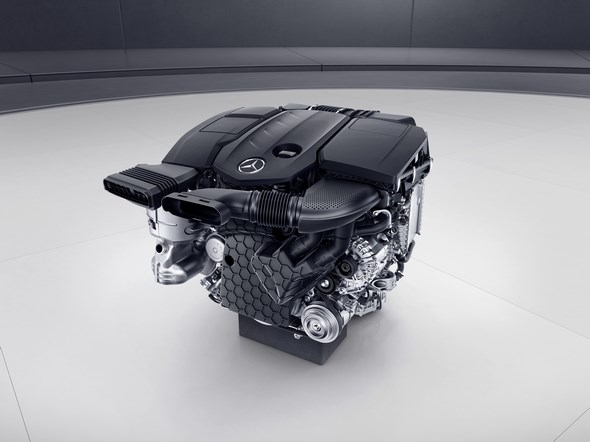
New engine generation
At launch, the E 200 model of the new E-Class will be available with a four-cylinder petrol engine while the E 220 d will be powered by an all-new four-cylinder diesel engine.
The E 350 d with six-cylinder diesel will follow in the summer.
Further model variants will be added to the range after the market launch, including the E 350 e featuring hybrid technology.
The Plug-In Hybrid impresses with its dynamism and efficiency, allowing around 30 kilometres of all-electric and therefore locally emission-free driving.
Its four-cylinder petrol engine, in conjunction with a powerful electric motor, gives it a total system output of 210 kW (286 hp) with a system torque of 550 Nm.
With this set-up, the E 350 e achieves the performance of a sports car yet consumes less fuel than a small, compact-class car.
Further newcomers will be the E 300 rated at 180 kW (245 hp) with a torque of 370 newton metres as well as the E 400 4MATIC, whose six-cylinder petrol engine will deliver 245 kW (333 hp) with a torque of 480 newton metres.
Further variants will later complete the engine range, including a new four-cylinder diesel unit developing 110 kW (150 hp).
The range of petrol engines will comprise four-cylinder versions with outputs ranging from 135 to 180 kW (183 to 245 hp) plus a six-cylinder variant developing 245 kW (333 hp).
The most important data at a glance
| Model | Displacement cc | kW/hp | Nm | 0-100 km/h in s | l/100 km | CO2 g/km |
| E 200
| 1991 | 135/184 | 300 | 7.7
| 5.9
| 132
|
| E 300 | 1991 | 180/245 | 370 | 6.3 | 6.6 | 149 |
| E 400 4MATIC | 2996 | 245/333 | 480 | 5.3 | 7.7 | 174 |
| E 220 d
| 1950 | 143/194 | 400 | 7.3 | 3.9 | 102 |
| E 350 d | 2987 | 190/258 | 620 | 5.9 | 5.1 | 133 |
| E 350 e System output | 1991 | 210/286 (155+65 211+88) | 550 (350+ 440) | 6.2 | 2.1 | 49 |
All figures provisional
All engines for the new E-Class are equipped with the ECO start/stop function. The petrol engines meet the requirements of the EU 6 emissions standard, while the new OM 654 four-cylinder diesel engine is already configured with future RDE limits in mind.
All-new four-cylinder diesel engine
The new four-cylinder diesel unit marks the birth of a new Mercedes-Benz engine family and opens up new dimensions in efficiency.
What’s more, it is shorter and more compact than its predecessor thanks to reduced cylinder spacing (90 mm instead of 94 mm).
Despite having a lower displacement than its predecessor, reduced to just under two litres, the new diesel powerplant has an output of 143 kW/194 hp and, when installed in the E 220 d, delivers an NEDC combined consumption from 3.9 litres per 100 kilometres, which equates to CO2 emissions from 102 grams per kilometre – a figure that until now only significantly smaller vehicles have been able to deliver.
Furthermore, the four-cylinder engine with single-stage turbocharging and variable turbine geometry is exceptionally refined.
Both the cylinder head and the crankcase are made of aluminium. The Mercedes-Benz-developed NANOSLIDE® surface coating efficiently reduces the friction between cylinder surface and steel piston.
Nine-speed automatic transmission
All models available at market launch are equipped as standard with the new 9G‑TRONIC nine-speed automatic transmission.
It enables fast gear changes and allows low engine revs, which has a particularly beneficial effect on efficiency and noise levels.
Suspension – sporty comfort
The suspension on the new E-Class offers agile driving pleasure on twisting roads as well as the highest level of ride comfort in this segment. The saloon comes with steel suspension as standard.
Three suspensions with selective damping are available in conjunction with this system:
- AGILITY CONTROL suspension with comfort tuning
- AGILITY CONTROL suspension, lowered by 15 millimetres; included in Avantgarde Exterior
- DYNAMIC BODY CONTROL: a sporty suspension with adaptive damping adjustment, lowered by 15 millimetres, which replaces the classic sports suspension
AIR BODY CONTROL multi-chamber air suspension
Alternatively the new E-Class can be equipped with multi-chamber air suspension all round – the only car in its segment to offer this option.
Advantages of this system: three chambers of different size in the spring struts of the rear axle and two in the spring struts of the front axle make it possible to control, in three stages, how stiffly the suspension reacts.
In this way, the occupants enjoy soft basic suspension, and the secure feeling of good handling stability as the speed increases.
Furthermore, the highly sensitive and fast-responding AIR BODY CONTROL multi-chamber air suspension features all-round self-levelling for excellent ride comfort even with the vehicle loaded.
It controls the ride height automatically depending on the speed and reduces fuel consumption on the motorway, for example, by lowering the vehicle.
When driving on rough roads or access roads, the ground clearance can also be increased at the push of a button using the ride height adjustment switch.
The multi-chamber air suspension is augmented by a continuously operative, electronically controlled adaptive damping system.
The damping at each individual wheel is adjusted fully automatically to suit the current driving situation and the condition of the road – such as in the case of evasive manoeuvres or on rough tracks.
The system therefore delivers good road roar and tyre vibration characteristics, excellent ride comfort, and outstanding driving dynamics.
What’s more, a DYNAMIC SELECT switch in the cockpit enables the driver to select from four AIR BODY CONTROL modes: “Comfort”, “ECO”, “Sport” and “Sport +”. The additional “Individual” option allows drivers to configure their vehicle to suit their own preferences.
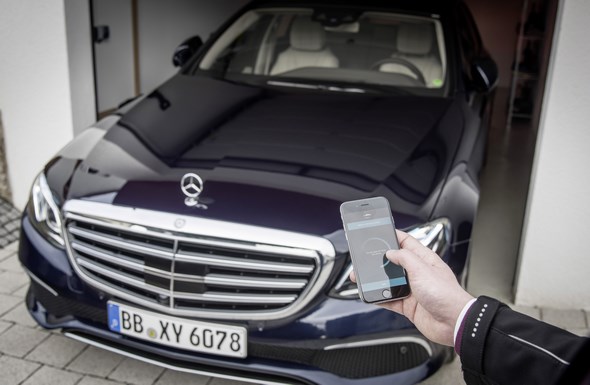
Next-generation driving assistance systems
Mercedes-Benz’s new assistance and safety systems enhance safety, comfort and driver assistance to new levels. Active Brake Assist is fitted as standard.
It is able to warn the driver of impending collisions, provide optimum support with emergency braking and if necessary also autonomously apply the brakes.
In addition to slower-moving, stopping or stationary vehicles, it can also detect pedestrians crossing the danger zone ahead of the vehicle.
Likewise included as standard are ATTENTION ASSIST with adjustable sensitivity, which can warn the driver of inattentiveness and drowsiness, and Crosswind Assist, which can assist the driver by substantially reducing the effects of strong crosswinds to prevent the vehicle from drifting too far off track.
Highlights of the optional Driving Assistance package that make the E-Class the most intelligent saloon in its class include:
- DRIVE PILOT: this system represents Mercedes-Benz’s next step along the road to autonomous driving. As Distance Pilot DISTRONIC, it is not only able on all types of road to keep the car the correct distance behind vehicles in front automatically, it can also follow them at a speed of up to 210 km/h for the first time. This can make life easier for the driver, who no longer needs to operate the brake or accelerator pedal during normal driving and also receives plenty of steering assistance from the Steering Pilot – even on moderate bends. Another unique feature at speeds up to 130 km/h is the fact that, like in a swarm, the system can continue to actively help with the steering by taking account of surrounding vehicles and parallel structures, even if the lane markings are unclear or non-existent, like at road works. The system therefore makes driving much easier, especially in traffic jams or heavy congestion. Another feature that helps to relieve the workload on the driver in such situations is the extended restart function, which allows automatic starting of the vehicle within 30 seconds following a stop initiated by the Distance Pilot DISTRONIC on motorways or similar roads. As the latest generation of the front radar is heated, this additionally increases the availability of Distance Pilot DISTRONIC, especially in wintry conditions.Further innovation designed to relieve stress: in combination with COMAND Online, the selectable Speed Limit Pilot subfunction can autonomously adjust the vehicle’s speed via Distance Pilot DISTRONIC in response to camera-detected speed limits, including gantries and signs at roadworks, or speed limits logged in the navigation system, e.g. 50 km/h in built-up areas or 100 km/h on country roads.Impressive DRIVE PILOT innovations include an Active Lane-change Assistant. This radar and camera-based assistance system assists the driver when changing lanes on motorway-like multi-lane roads and can steer the vehicle into the lane selected by the driver – when overtaking, for example. Once the driver has indicated to turn for at least two seconds, the Active Lane-change Assistant assists with steering into the adjacent lane if it detects that the lane is unoccupied.Integrated into DRIVE PILOT, Active Emergency Stop Assist can brake the vehicle to a standstill in its lane if it detects that the driver is permanently no longer taking control while on the move.
- If there is no steering wheel movement over a longer period when the Steering Pilot is activated, the system gives the driver a visual and audible prompt to place his/her hands on the wheel. If, after being repeatedly warned, the driver does not react by steering, accelerating, braking or pressing a Touch Control button, the vehicle safely decelerates to a standstill in the lane and warns the following traffic by means of the hazard warning lights.
- Active Brake Assist with cross-traffic function: compared with the standard version, it offers extended speed thresholds with regard to vehicles and pedestrians. Furthermore, it can detect crossing traffic at junctions and, if the driver fails to respond, apply the brakes autonomously. For the first time, it can also detect hazardous situations at the tail end of traffic jams where there is no room to manoeuvre and initiate autonomous braking far sooner in such situations. Consequently, it is possible to completely avoid accidents at speeds up to 100 km/h or substantially reduce the severity of accidents at speeds above this level.
- Evasive Steering Assist: this likewise new system ideally complements the pedestrian detection function of Active Brake Assist. If the driver deliberately or instinctively initiates an evasive manoeuvre in a hazardous situation, this function can add precisely calculated steering torque to support the movement of the steering wheel. This helps the driver to avoid the pedestrian in a controlled manner while subsequently facilitating the straightening-up of the vehicle to allow the situation to be negotiated safely.
- Advanced assistance systems: the intelligent assistance systems in the new Driver Assistance package also include proven systems that have been further developed in terms of their mode of operation and the sensors they use. Active Lane Keeping Assist can help stop the driver from unintentionally changing lane, this being done by corrective one-sided application of the brakes in the case of solid or broken lane markings and risk of collision, e.g. with oncoming traffic or fast overtaking vehicles. Active Blind Spot Assist can now also warn of the risk of a lateral collision in typical urban traffic at low speeds and, in addition, as before, correctively intervene at the last moment to prevent a collision at speeds above 30 km/h and activate the PRE-SAFE® belt tensioners. PRE-SAFE® PLUS can protect against collisions with following traffic and their impacts on the occupants by warning the vehicle behind, activating the PRE-SAFE® belt tensioners and, if stationary, by applying the brakes to stop the vehicle from being shunted. In addition, the functionality of Traffic Sign Assist has been extended to include, for example, a warning of people in the vicinity of zebra crossings and an extended wrong-way warning function.
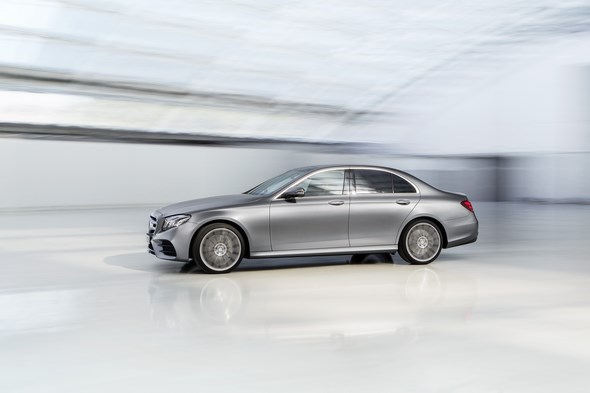
Furthermore, the range of new features in the new E-Class includes:
- Remote Parking Pilot: for this first time, this system allows the vehicle to be moved into and out of garages and parking spaces remotely using a smartphone app, enabling the occupants to get into and out of the car easily, even if space is very tight.
- Car-to-X communication: in 2013, Mercedes-Benz was the first manufacturer to introduce widespread car-to-car networking in the form of a retrofit solution. This is now followed by the logical next step as the world’s first fully integrated Car-to-X solution goes into series production. The mobile phone-supported exchange of information with other vehicles further ahead on the road, for example, can effectively allow the driver to “see around corners” or “through obstacles” well in advance. This means that the driver receives an earlier warning than previously in the event of imminent danger, such as a broken down vehicle at the edge of the road or also in the event of heavy rain or black ice on the road ahead. In this case the new E-Class simultaneously acts as a receiver and a transmitter, since warning messages are conveyed automatically by evaluating vehicle statuses or manually by the driver into the Mercedes Cloud. The Car-to-X warning messages are shown directly on the navigation map. Some warnings are also communicated to the driver by voice output, which is particularly useful where the road layout is unclear.
- PRE-SAFE® Impulse Side: this system is part of the Driving Assistance package PLUS. If a lateral collision has been detected and is imminent, it can move the driver or front passenger away from the danger zone in a sideways direction by way of precaution. To do this, the system inflates an air chamber in the side bolster of the front seat backrest nearest the side of the imminent impact in a fraction of a second, thus increasing the distance between occupant and door and, at the same time, reducing the forces acting on them.
- PRE-SAFE® Sound: this system is based on a human reflex in the inner ear, called the stapedius reflex. PRE-SAFE® Sound emits a short interference signal through the vehicle’s sound system if the risk of a collision is detected. This signal can trigger the natural reflex and thus prepare the occupants’ ears for the expected sound of the accident, in order to reduce the stress on the occupants.
- High-resolution MULTIBEAM LED headlamps, each with 84 individually controlled high-performance LEDs, automatically illuminate the road with a hitherto unsurpassed, precision-controlled distribution of exceptionally bright light – without dazzling other road users. That’s because this grid allows the light distribution of the left and right headlamps to be controlled separately and adapted to the changing situation on the road quickly and dynamically. All functions of the Intelligent Light System in low-beam and high-beam mode can furthermore be depicted purely digitally and without mechanical actuators for the first time, including, as a world first, a purely electronically implemented active light function.
- Digital Vehicle Key: this drive authorisation system uses Near Field Communication (HFC) technology and allows the driver’s smartphone to be used as a vehicle key.
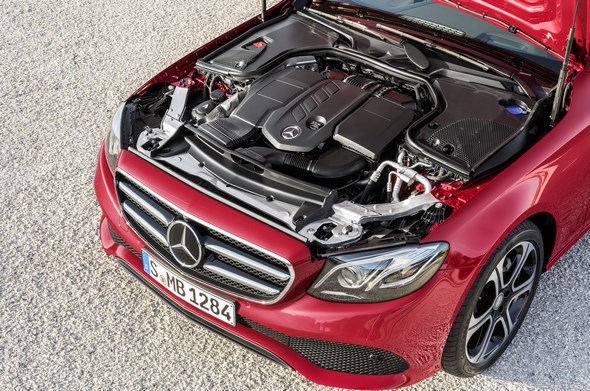
Multifunction Telephony – ideally connected, and not a cable in sight
An all-new infotainment generation is making its debut in the E-Class equipped with COMAND Online. Its highlights, alongside the double display, include the touch-sensitive Touch Controls on the steering wheel and the new, intelligent graphic design of the Multifunction Telephony.
It allows mobile phones to be charged and, at the same time, connected to the vehicle’s exterior aerial – with absolutely no need for cables or a telephone holder.
The wireless, inductive charging system works with all mobile devices that either support the Qi standard or can be upgraded to this standard.
The charging pad, built into the stowage facility at the front of the centre console, is compatible with mobile phones with a screen diagonal of up to 15.2 cm (6 inches).
When the “NFC” logo is touched, the system connects the mobile phone to the infotainment system and the exterior aerials via Near Field Communication (NFC). Phone calls can then be made via the Bluetooth® hands-free system.
If the vehicle is equipped with COMAND Online, it is also possible to use Apple’s smartphone-based infotainment system CarPlay® as well as Google’s Android Auto™.
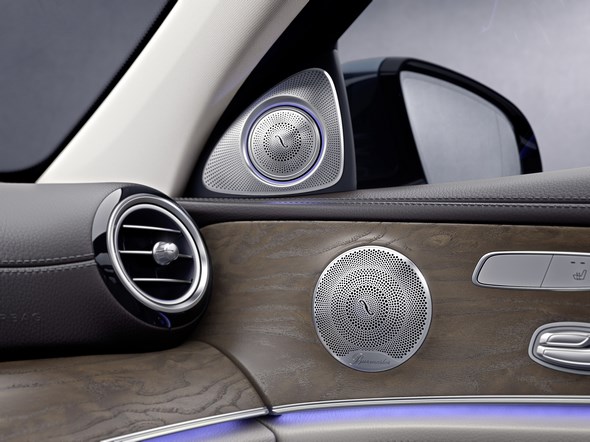
Three-dimensional listening pleasure
Fitted as standard, the Mercedes-Benz-developed Frontbass system in the new E‑Class delivers a unique listening experience.
It uses the space in the cross-member and side member of the body structure as a resonance chamber for the bass speakers.
If the vehicle is additionally equipped with the optionally available Burmester® high-end 3D surround sound system with 23 speakers, the occupants are treated to a listening experience reminiscent of the acoustics in a concert hall thanks to roof speakers.
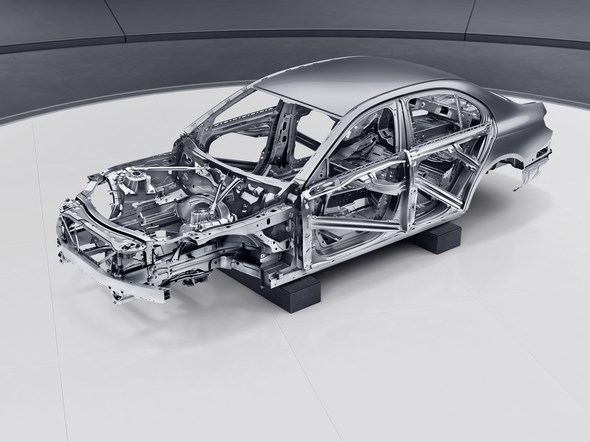
Robust yet lightweight bodyshell
An outstandingly stiff body forms the basis for exceptional handling, astonishingly low noise and vibration levels, and a high level of crash safety.
To achieve this, the engineers opted for a bodyshell with a far higher proportion of aluminium and ultra-high-strength steel components than its predecessor.
The front wings, bonnet, boot lid, and large sections of the front and rear ends are made of sheet or cast aluminium. This lightweight design reduces fuel consumption and makes for tangibly sporty and agile vehicle handling.
Against the wind
Aerodynamic performance is one of the main reasons behind the outstanding efficiency of the new E-Class. Here the E-Class raises the benchmark with a record-breaking drag coefficient (Cd value) of 0.23.
To achieve this, the aerodynamics experts optimised numerous details and implemented new ideas. By way of example, the AIRPANEL shutter system, available for most engines in the EXCLUSIVE line and base models, opens the radiator grille by means of adjustable louvres when extra cooling is required and additionally features a second shutter in the air intake beneath the number plate to further improve the system’s overall performance.
The sophisticated aerodynamics additionally minimise wind noise and ensure that the new E-Class is even quieter than some luxury-class models.
Considerably more intelligent, but hardly more expensive
The new E-Class is available from 45,303.30 euros (E 200). This means that, with a similar equipment specification, its price is only slightly higher than that of corresponding previous models.
For example, despite significant increases in intelligence and output (143 kW/194 hp versus 125 kW/170 hp) with considerably lower consumption (3.9 litres versus 4.5 litres per 100 kilometres) with automatic transmission, the E 220 d costs almost the same as its comparable predecessor (47,124.00 versus 46,945.50 euros).
The new E-Class will be in dealer showrooms from April 2016.
The Mercedes-Benz management team on the new E-Class
Prof Dr Thomas Weber, Member of the Board of Management of Daimler AG and responsible for Group Research and Mercedes-Benz Cars Development: “The E-Class is the core of the Mercedes-Benz brand and in the past has repeatedly redefined the standards in the executive-class segment.
Now it carries this tradition into the future with a wealth of top-class innovations. The new E-Class takes another major step towards autonomous driving.
In addition, it enhances efficiency, safety and comfort, reduces the stress level when driving and intensifies the motoring pleasure.”
Ola Källenius, Member of the Board of Management of Daimler AG, Mercedes‑Benz Cars Sales & Marketing: “With our new E-Class we are continuing to write the long history of this model series in impressive style in what is now the tenth generation.
With its innovative engineering it enables a new driving experience and together with the exclusive high-quality interior it systematically implements the high Mercedes-Benz standards.
I am sure that the new E-Class will delight our customers and add fresh impetus to the business class.”
Gorden Wagener, Vice President Design Daimler AG: “With its contemporary luxury, the new E-Class embodies the perfect interpretation of the design philosophy of sensual purity, both in the exterior and in the interior.
It is the most beautiful and luxurious E-Class of all time while also exuding a sporty elegance. In addition, it is the first Mercedes-Benz model with the catwalk line.”
Hartmut Sinkwitz, Director Interior Design: “With its emotively appealing design idiom, intelligent interior architecture and ultra-modern controls/displays, the new E-Class embodies the ideal fusion of craftsmanship and high-tech experience.”

Highlights of the new E-Class at a glance
- Wide-screen cockpit with high-resolution double display, individually configurable
- Touch Controls for controlling the entire infotainment system using finger swipes
- New, intelligent graphic design with high-resolution visualisations and animations, together with a simplified logic
- Comprehensive smartphone integration: digital vehicle key, wireless charging, capacitive aerial coupling, support of smartphone-based infotainment systems (Apple’s CarPlay® and Google’s Android Auto™)
- Extended Driving Assistance package with DRIVE PILOT, Distance Pilot DISTRONIC with extended restart function in stop & go traffic, Active Lane-change Assistant, Active Emergency Stop Assist, Speed Limit Pilot, Active Brake Assist with cross-traffic function, Evasive Steering Assist, Active Lane Keeping Assist, Active Blind Spot Assist and PRE-SAFE® PLUS
- New Parking Pilot functions including Remote Parking Pilot
- Car-to-X communication
- Improved PRE-SAFE® protection concept with new PRE-SAFE® triggering scenarios
- PRE-SAFE® Impulse Side in Driving Assistance package Plus
- PRE-SAFE® Sound
- Beltbag for passengers in the outer rear seats
- New four-cylinder diesel engine
- 9G-TRONIC nine-speed automatic transmission
- AIR BODY CONTROL air suspension
- Best of bench for drag coefficient (Cd as low as 0.23)
- Quietest vehicle in its segment
- Best of bench for interior sizes and entry/exit.
- Ambience lighting with 64 colours
- MULTIBEAM LED headlamps each with 84 individually controlled high-performance LEDs and adaptive Highbeam Assist PLUS
- Tail lights with stardust effect and multi-level functionality
Design
Dynamic, exciting, powerful
With a contemporary, clear elegance and dynamically sensual looks, the new E-Class visibly reflects the current values of the premium brand while at the same time radiating a high-tech character.
The design of the saloon is thus style-defining and superior.
The design of the new E-Class impresses with its hallmark Mercedes saloon proportions. The elongated bonnet coupled with a coupé-esque roof flowing into a sensual, broad-shouldered tail end creates an exciting silhouette.
Short overhangs, long wheelbase and large wheels emphasise the athletic character of the vehicle. The distance from the front wheel arch to the door opening, which is a measure of comfort, is exceptionally large in the case of the new E-Class, thus confirming its unique position.
The taut well-defined flanks display a fresh, stylish and dynamic interpretation of the feature line, which develops from the headlamps and extends over the whole vehicle length.
A sculptural reverse curve in the lower region of the doors and in the bumper visually resumes the feature line while ensuring a stylistic tension.
Low, stretched-looking side windows, surrounded by high-grade discontinuous aluminium trim around the window outline also contribute to the muscularly stretched vehicle body, which appears to be visually more compact than it actually is.
The E-Class thus systematically embodies the Mercedes-Benz design philosophy of “sensual purity”.
Front with prestige look
The new E-Class clearly shows a muscular front end that boasts a different look for each design and equipment line.
The base version features the classic Mercedes radiator grille with the star on the bonnet, as does the EXCLUSIVE line – albeit in a different fashion.
The AVANTGARDE and AMG Line models are identifiable by the sports radiator grille with a large Mercedes star as its centrepiece. Each of the radiator grille variants lends the E-Class a distinct character.
Distinctive headlamps
The intelligence of the new E-Class is reflected also in the headlamps. A characteristic element is the double eyebrow of the reinterpreted daytime running lamps.
The face of the vehicle is shaped by distinctive headlamps with a clear-lens design.
The basic version of the E-Class comes with H7 headlamps. Static High Performance headlamps and MULTIBEAM LED headlamps are optionally available.
They give the saloon a majestically focused look while featuring an unmistakable design, also by day, with double torch and high-quality modelled details.
A striking feature is the integration of the brand-typical daytime running lamp design in the High Performance and MULTIBEAM LED headlamps.
Following the inner contour, it gives a distinctive note to the direction indicators, Coming Home lights, side lights and daytime running lamps.
The result is that, in both their night and day design, the Mercedes-Benz E-Class models are uniquely identifiable, standing apart from other vehicles at the visual level.
All the headlamp functions are grouped under a lens of clear polycarbonate with scratch-resistant coating. Like various other design elements, the housing is in black, giving an impression of both quality and depth.
Sporty rear end with stardust
Single-piece tail lights featuring a two-bar design framed by the vehicle body clearly identify the E-Class as a new member of the Mercedes saloon family.
Similarly to the front end, the tail lights are equally tautly drawn. The torch design of the tail lights emphasises – also in the night design – not only the characteristic form of the tail lights, but also makes for improved safety.
Optionally available rear lights provide an additional highlight reminiscent of stardust, the Milky Way or the glow of a jet engine.
This “stardust” effect is created by an innovative reflector technology with a specially designed surface structure for the tail light and ensures a brilliant appearance. The optionally available rear light uses all-LED technology.
The newly designed rear lights are also brilliant in terms of safety. For example, the light intensity of the brake lamp – and also the direction indicators – varies between daytime and night-time within the legally permissible limits (multi-level functionality).
A black insert in the rear bumper gives the rear end a lighter and therefore sportier look. All equipment lines come with a two-part rear bumper and visible stainless steel tailpipe trims integrated into the bumper (except Basic line).
Interior
Next Level Interior Design
With its emotional design idiom on the one side and intelligent interior architecture as well as highly advanced control and display elements on the other, the interior of the new E-Class ideally embodies the synthesis of the two opposite poles of emotion and intelligence.
The eye-catcher in the comfort-oriented, luxurious interior of the new E-Class is two displays each with a 31.2 cm (12.3-inch) screen diagonal and a resolution of 1920 x 720 pixels.
These merge visually to form a wide-screen cockpit, thus acting as a central element to emphasise the horizontal bias of the interior design of the new E-Class.
As the instrument cluster, this wide-screen cockpit contains a large display with virtual instruments in the direct field of vision of the driver as well as a central display above the centre console.
A common glass cover results in a modern flat-screen look. The driver can choose between three different styles to select their preferred screen design for the wide-screen instrument cluster: “Classic”, “Sport” and “Progressive”.
The wide-screen instrument cluster is optionally available with COMAND online. Instead, the entry-level model of the new E-Class combines two tube-type round dials and a 17.8 cm colour display cluster (1000 x 600-pixel resolution) with a central display with a 21.3 cm screen diagonal (960 x 540-pixel resolution).
The round dials, instrument cluster and central display are installed in a single frame with a high-gloss piano-lacquer look.
The driver can adapt the content of the central display to suit their personal preferences. With the exception of the navigation map (which always fills the complete display area), the central display of COMAND online is divided into a main area for informative graphics and animations (2/3 on the right side of the display) and a supplementary area (1/3 on the left side of the display).
The display can be backlit at night with multicolour ambience lighting – which then makes the wide-screen cockpit appear to float in space.
Touch Control: finger swipes
In a further innovation, the new E-Class is the first ever car to integrate touch controls in the spokes of the multifunction steering wheel.
Like the surface of a smartphone, the two buttons are touch-sensitive and therefore respond precisely to horizontal and vertical finger swipes.
This enables the driver to control every function of the infotainment system in a simple, logical and ergonomically perfect manner in a minimum of space without having to take their hands off the steering wheel.
Having selected the desired function with a swipe, the driver presses the appropriate touch controls to trigger the function.
Another four buttons in each switch panel are provided with the familiar functions, such as for volume control and telephone control.
A further input option, familiar from the C-Class, is offered by the Touchpad on the centre console. This, too, allows all functions to be controlled by single or multi-finger gestures (multitouch).
The Touchpad also permits letters, numbers and special characters to be entered in handwriting. The system reads out characters detected by handwritten input so that the driver need not avert their gaze from what is happening on the road.
A handrest detection feature makes for added operating safety while helping to prevent incorrect inputs. Three touch-sensitive buttons are arranged behind the Touchpad and can be used to operate key functions quickly and directly (back function, switch to favourites menu, audio quick menu).
In addition, the driver can use the COMAND Controller and LINGUATRONIC voice control to control the infotainment system. They can choose at any time which input method they prefer.
The new E-Class can also be controlled by direct buttons, such as for controlling the air-conditioning system or – in another first – for simple activation/deactivation of certain driving assistance systems.
In designing the control and display elements, the aim was not only to logically group the vehicle’s controls and display functions in terms of form and content, but also to upgrade and emphasise them.
New control experience
The various control possibilities are coupled with an all-new control and display concept. The goal was to closely combine intuitive use with a functionally meaningful and also attractive design.
The result is that passengers in the E-Class can enjoy a new control experience with high-resolution visualisations and animations.
The developers have focused on the use of newly implemented presentation and display techniques to make it easier – i.e. more intuitive – for the driver to register and experience information.
For example, animated displays are used to show the mode of action of assistance systems, or of DYNAMIC SELECT.
The likewise animated ECO display in the instrument cluster helps the driver to adopt an economical driving style in an easily understandable manner.
The new look also comes with a novel, clearer menu structure that makes functions easier to select and which, in many cases, leads efficiently to the desired outcome in a manner appropriate to the situation.
Ergonomics and intuitiveness of use were the key criteria for the developers.
With user experience and connectivity ever more in the spotlight, Mercedes-Benz has set up two new centres to address the digital future: “Digital Graphic & Corporate Design” and “User Interaction”.
These centres are closely networked for designing the control and display concepts, i.e. the user interface, for current and future vehicles.
This is because, alongside a workplace and private environment, the vehicle interior is increasingly becoming a “third place”, a living area in which passengers can enjoy contemporary luxury.
With the new department, Daimler is responding to the global trend of “Digital & Connected Life” and thus the rapid advance of digitalisation in all areas of life.
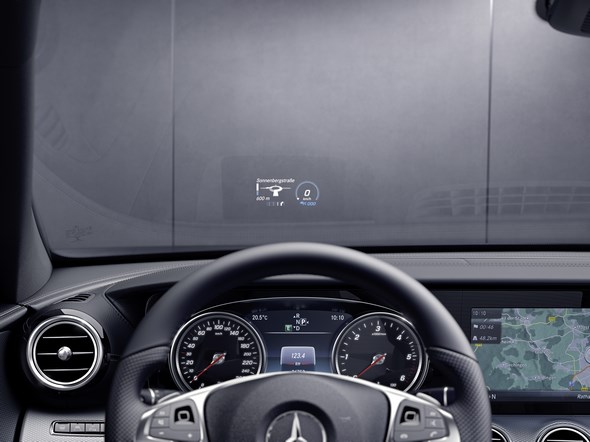
Focus on information from the Head-up Display
A Head-up Display is a new feature in the E-Class. As in a jet fighter, it projects important information directly into the driver’s field of vision on the windscreen, ensuring that there is less distraction from the road ahead.
The system provides information on speed, speed limits, navigation instructions and messages from DISTRONIC.
The driver can adjust the height of the virtual image so that it can be easily viewed. On vehicles with seat memory function this feature stores the individual settings.
A range of display content can also be enabled or disabled, and the brightness of the display adjusted individually.
Interior as expression of emotion and intelligence
The interior of the new E-Class combines the elegance of the luxury class with the modern sportiness of the C-Class.
The design idiom of the new executive saloon is characterised by an interplay of strong solid bodies with sculptural surfaces and an avant-garde clarity and extensiveness of control and display zones.
This gives rise to an entirely distinctive, contrast-rich Mercedes-Benz design language that optimally reflects the design philosophy of sensual purity.
The horizontal, low-lying trim part of the instrument panel with its elegantly sweeping form and flowing lines creates a visual sense of space.
The wrap-around of the wave motion into the door linings provides a continuation of the horizontal emphasis on width with timeless sweeping forms.
This is typical of the design of Mercedes-Benz saloons from the C-Class to the S-Class. Four circular air vents as in the S-Class make it additionally clear that the new E-Class is closely focused on the luxury segment.
Above the low-lying trim part is a formally coherent and separate solid body, which is forceful and sporty in appearance, as if the upper part of the instrument panel is floating in space.
Free-standing yet successfully integrated, the wide-screen display stands in front of the upper part of the instrument panel.
Ultra-flat and smoothly glazed across its entire area, the high-resolution screen is of a uniquely superior quality of manufacture.
It lends the interior an avant-garde quality that forms a contrast between the design of state-of-the-art consumer electronics and the classically elegant automotive design of the passenger compartment.
With its emotional design idiom on the one side and intelligent interior architecture as well as highly advanced control and display elements on the other, the interior of the new E-Class perfectly embodies the synthesis of the two opposite poles of emotion and intelligence.
Depending on the transmission variant, the new E-Class comes with two differently designed centre consoles. Models with automatic transmission have a straight-through centre console, with a dynamically rising, high connection to the cockpit, by a control panel in a “Black Panel” glass look. Other controls, such as in the doors, also feature the “Black Panel” look. Conversely, models with manual transmission are provided with a centre console in the form of two separate trim parts.
Intelligent material design
Modern and high-grade materials define the both sporty and elegant style of the interior. They include open-pore woods, wood in a yachting look with flowing lines as a contemporary interpretation of inlaid wood and a novel metal fabric.
The use of authentic materials is also continued in the leather-covered doors and the beltline for selected lines.
Another Mercedes hallmark clearly in evidence is the high-quality look and feel created through meticulous attention to detail and craftsmanship.
Just as carefully composed is the material and colour concept with various shades of brown, including new attractive colour combinations such as nut brown/macchiato and saddle brown/macchiato.
Lighting atmosphere with 64 colours
The interior lighting makes exclusive use of durable, energy-saving LED technology. The same applies to the optionally available enhanced ambience lighting.
With 64 colours, it offers a host of possibilities for personalisation. It adds touches of light, for example, to the trim parts, central display, front stowage facility on the centre console, handle recesses, door pockets, front and rear footwells, overhead console, mirror triangle and tweeters (if the vehicle is equipped with the Burmester® high-end 3D surround sound system).
Seat design: first class
A further highlight of the new E-Class is its seats, which create an ergonomic, sculptural impression with their torso form, uniting Mercedes-Benz’s typical suitability for long journeys with a sporty look. The seats are differently designed depending on the line:
- even the basic fabric version emphasises the luxurious ambience of the new E-Class.
- The sporty bias and adapted contours of the seats for the AVANTGARDE line, the centre sections of which are transversely stitched, put the accent on sportiness with good lateral support and back-ventilation (optional).
- The newly developed seat for the AMG Line impresses with a backrest with sporty side bolsters and a wide shoulder section for added lateral support.
- The EXCLUSIVE line comes with longitudinally stitched centre sections, colour-matched to the overall seat sculpture in fabric/leather combination or nappa leather.
Also available is a diamond-patterned designo seat in the centre section with perforations similar to the S-Class seat and the enhanced lateral support of the sports seat.
Furthermore, the following additional options, among others, are available for the seats:
- Seat Comfort package with electro-pneumatic 4-way lumbar support, manual seat cushion depth adjustment by around 60 millimetres for individual adjustment of the thigh support as well as electric seat angle adjustment. The Seat Comfort package meets the criteria of the German association Aktion Gesunder Rücken e.V.
- Fully electric seat with Memory package with novel electric seat cushion depth adjustment offering an adjustment travel of 60 mm as a one-part cushion without gap. The package also includes 4-way lumbar support and electronic head restraint adjustment. The controls for seat adjustment, heating and seat ventilation are integrated in the door panel.
- Climatised seats for driver/front passenger with reversing seat ventilation for the front seats; electrically heated seats are also part of the seat ventilation package.
- Active Multicontour Seat package for the front seats. This includes the following functions: Energizing Massage, dynamic seat, multicontour backrest and – new – the active cushion. The scope of functions also includes fast seat heating Plus and a 6-way comfort head restraint that allows the occupant to adjust the side bolsters in order to provide the head with comfortable lateral support.
The functions of the Active Multicontour Seat package in detail:
- Multicontour backrest: allows infinitely variable adjustment of the side bolsters for individual adaptation of the contour of the backrest.
- Dynamic seat: offers additional lateral support when cornering by inflating the side bolsters of the backrest on the outside of the curve.
- Massage functions: have been extended for maximum comfort.
The massage functions include:
- Active Workout backrest and Active Workout cushion – these two new functions call on the driver/front passenger to actively participate by pressing back, thereby helping to strengthen the supporting muscles.
- Hot Relaxing Massage shoulder – treats the occupant to an intensive massage with additional heat, similar to a massage with the application of hot stones. Individual air chambers massage the parts of the shoulder and back in different sequence and intensity.
- Activating Massage and Mobilizing Massage – activate/stimulate tired areas of the back.
- Wave massage – makes a wave-like transition through the backrest into the cushion and, in various intensities and speeds, offers a completely new massage experience for back and bottom.
Further innovations in comparison with the previous model are the heatable armrests for the driver’s door and the centre console as Heat Comfort package.
The rear bench seat in the new E-Class Saloon comes with the option of a three-piece backrest. It comes with a 40% – 20% – 40% split and is therefore more versatile than in the previous model series with 60% – 40%.
A further innovation is the through-loading feature by folding forward the entire middle 20% portion of the rear backrest.
The centre armrest in the 20% portion of the rear backrest houses a stowage box as well as two hinged drinks holders.
In addition, a tablet holder is optionally available for the rear passengers. This holder is accommodated in a shaft on the back of the driver’s backrest above the map pocket.
It serves to accommodate the holder and supply the devices with power.
Stowage concept for more interior space
A sophisticated stowage concept with extensive stowage options contributes to carefree travelling. The stowage volume in the standard specification has increased from 26.3 litres for the predecessor to now 27.7 litres (manual transmission) or 34.8 litres (automatic transmission).
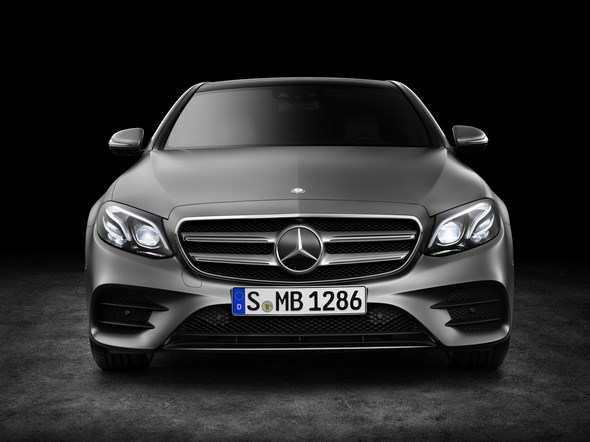
Aerodynamics
Reduced resistance
Outstanding fuel consumption figures require great aerodynamic properties. The new E-Class has the lowest drag coefficient in its segment.
At the same time, the aerodynamics engineers have minimised the wind noise, thereby making the E-Class the quietest saloon in the executive class.
From a speed of about 70 km/h, the aerodynamic drag exceeds the sum total of all other driving resistance factors.
Therefore, reducing the drag also helps to lower the fuel consumption and CO2 emissions. The metric for aerodynamics is the Cd value.
Lowering it by 0.01 means one gram of CO2 per km less in the driving cycle (NEDC), while, in terms of average real consumption, it means two grams.
Progress on the aerodynamic front has an even more significant effect at higher speeds – especially when driving on motorways. A Cd jump from 0.25 to 0.23 produces a fuel saving of around 0.3 litres per 100 kilometres at a constant
130 km/h.
Mercedes-Benz is setting the pace in the field of aerodynamics and delivers cars with the best drag coefficients (Cd values) in almost all vehicle classes.
The new E‑Class also follows this tradition: the saloon achieves a drag coefficient of from Cd = 0.23, which makes it the benchmark in the executive class.
Although the frontal area (A) of relevance for drag has risen in the new E-Class from the 2.31 square metres of the previous model series to around 2.33 square metres on account of the increased exterior dimensions, this is more than made up for by the reduced drag coefficient.
The drag area (Cd x A) is 0.54 m2, which means that it has been reduced by almost seven percent in comparison with the previous model.
| New E-Class | Predecessor | |
| Cd | up to 0.23 | up to 0.25 |
| A m2 | 2.33 | 2.31 |
| Cd x A m2 | 0.54 | 0.58 |
To achieve this goal, the aerodynamics engineers have performed intensive detail work during computer-based airflow simulations and optimisations in the wind tunnel and, based on the results, implemented a series of effective measures.
For example, in addition to the AIRPANEL air control system familiar from the C‑Class (opens and closes the radiator grille while driving by means of adjustable louvres depending on the required cooling), there is, for the first time, a second shutter in the front apron in the air inlet below the number plate.
This considerably improves the overall performance of the system.
Further detail measures include:
- aerodynamic design of front and rear aprons
- wheel spoilers at front and rear
- sealing between wheel arches and engine compartment
- new exterior mirrors with mirror base
- extended peripheral sealing of the headlamps with a tight connection to the radiator grille
- aero lip in the bonnet/front bumper joint
- improved sealing of the radiator section and flow properties to make efficient use of the available cooling air
- integral design of the spoiler lip at the rear, taking account of the boot lid and tail light geometry
- optimised underbody panelling concept with larger covers in the area of the front engine compartment
- aerodynamically optimised wheels and tyres
Best-in-class aeroacoustics
A special focus of the aeroacoustics development work was to minimise the wind noise. For example, door/window seals were carried over from the S-Class in order to reduce the high-frequency components of the wind noise.
Effective noise insulation also plays a major role in the extraordinarily quiet interior. Optionally available laminated safety glass in the Acoustic Comfort package can lower the wind noise even further.
The result is in terms of wind noise, the new E-Class occupies the top position in its segment and is thus the most comfortable long-distance executive saloon.
On the wind noise front, it even surpasses many premium luxury-class saloons. This allows effortless in-vehicle entertainment, listening to music, telephoning, use of LINGUATRONIC, including at high speeds.

Powertrain
New engine generation: redefining efficiency
Powerful and efficient petrol and diesel engines, all equipped with the ECO start/stop function and complying with Euro 6 emissions standard, provide for lively performance and great fun at the wheel – including a newly developed four-cylinder diesel engine.
Initially, the E 200 d models of the new E-Class will be available with an all-new four-cylinder diesel engine, while the E 200 will be powered by a four-cylinder petrol engine and the E 350 d by a six-cylinder diesel.
Further model variants will later be added to the range. These will include the E 350 e. This PLUG-IN HYBRID impresses with its dynamism and efficiency, allowing around 30 kilometres of all-electric and therefore locally emission-free driving.
Its four-cylinder petrol engine, in conjunction with a powerful electric motor, gives it a total system output of 210 kW (286 hp) with a system torque of 550 Nm.
With this set-up, the E 350 e achieves the performance of a sports car yet consumes less fuel than a small, compact-class car.
Further newcomers will be the E 300 rated at 180 kW (245 hp) with a torque of 370 newton metres as well as the E 400 4MATIC, whose six-cylinder petrol engine will deliver 245 kW (333 hp) with a torque of 480 newton metres.
The most important data at a glance
| Model | Displacement cc | kW/hp | Nm | 0-100 km/h in s | l/100 km | CO2 g/km |
| E 200
| 1991 | 135/184 | 300 | 7.7
| 5.9
| 132
|
| E 300 | 1991 | 180/245 | 370 | 6.3 | 6.6 | 149 |
| E 400 4MATIC | 2996 | 245/333 | 480 | 5.3 | 7.7 | 174 |
| E 220 d
| 1950 | 143/194 | 400 | 7.3 | 3.9 | 102 |
| E 350 d | 2987 | 190/258 | 620 | 5.9 | 5.1 | 133 |
| E 350 e System output | 1991 | 210/286 (155+65 211+88) | 550 (350+ 440) | 6.2 | 2.1 | 49 |
All figures provisional
Further variants will later complete the engine range, including the new four-cylinder diesel unit developing 110 kW (150 hp).
The range of petrol engines will comprise four-cylinder versions with outputs ranging from 135 to 180 kW
(183 to 245 hp) plus a six-cylinder variant developing 245 kW (333 hp).
All engines for the new E-Class are equipped with the ECO start/stop function. The petrol engines meet the requirements of the EU 6 emissions standard, while the new OM 654 four-cylinder diesel engine is already configured with future RDE limits in mind.
All-new four-cylinder diesel engine
The new four-cylinder diesel unit marks the birth of a new Mercedes-Benz engine family and opens up new dimensions in efficiency.
Despite having a lower displacement than its predecessor, reduced to just under two litres, and weighing around 16 percent less, the new diesel powerplant has an output of 143 kW/ 194 hp, precisely 18 kW more than the previous engine, and, when installed in the E 220 d, delivers an NEDC combined consumption of 3.9 litres per 100 kilometres, which equates to CO2 emissions of 102 grams per kilometre – a figure that until now only significantly smaller vehicles have been able to deliver. On top of all this, the engine is also more compact than its predecessor.
These advantages have a noticeable effect. The lower weight and extra output give more agility and enhanced driving pleasure; its compact dimensions mean that the engine can be used in a range of different powertrain configurations, as well as for all-wheel-drive and hybrid vehicles.
The engine is also already designed to meet future legislation on emissions (RDE – Real Driving Emissions). In future, exhaust gas aftertreatment systems will not only have to meet the prescribed emission limits on the test stand, but also under a wide range of real-life conditions.
The WLTP cycle (Worldwide harmonized Light vehicles Test Procedure), which is scheduled to supersede the NEDC measuring cycle in future, was another focus of attention during the development phase.
Over and above this, the design of Mercedes-Benz’s new diesel engine offers potential for further development in terms of both output range and integration of further technology modules, for example in order to take advantage of the opportunities presented by further advances in electronics.
Further development of tried-and-tested 6-cylinder diesel engine
The E-Class carries over from the previous model series the 6-cylinder diesel engine with 190 kW output and 620 Nm torque.
However, the charge-air cooling has been changed to an air/water system. This contributes to increased agility.
The petrol engines: powerful, fast and clean
The BlueDIRECT four-cylinder petrol engines in the E-Class combine spontaneous response and high output with efficiency and low emissions.
Third-generation direct injection with spray-guided combustion. The system pressure is up to 200 bar, the pressure being variably optimised according to the engine’s mapping.
Piezo injectors enable optimal mixture formation with up to five injections per power stroke.
The third-generation direct injection is supplemented by rapid multi-spark ignition (MSI). The MSI system enables up to four sparks to be discharged in succession within one millisecond, creating a plasma with a larger spatial expansion than conventional ignition.
The rapid multi-spark ignition can be controlled to vary both the timing of the sparks and the combustion period to suit the relevant operating point.
This provides scope for optimising the centre of combustion and improved residual gas compatibility. This in turn reduces fuel consumption. The result of this is excellent utilisation of the fuel with minimum emissions.
Nine-speed automatic transmission for more comfort and efficiency
In addition to a 6-speed manual transmission for the four-cylinder petrol engines, Mercedes-Benz offers the new 9G-TRONIC nine-speed automatic transmission as standard for all E-Class models.
Its broad ratio spread (9.15) for gears one to nine allows an overall reduction in engine speed ‒ a key factor behind the high level of energy efficiency and ride comfort.
Shortened shift and response times ensure optimum immediacy combined with outstanding ease of shifting. This is linked to the transmission’s high efficiency, which is a noticeable advantage in terms of fuel consumption.
4MATIC all-wheel drive
For the first time, the E 200, too, will be available with 4MATIC permanent all-wheel drive. It improves traction and driving stability, especially under difficult road conditions.
As ever, the combination of the ESP® driving dynamics control system with the 4ETS electronic traction system makes regular differential locks superfluous.
This saves weight and noticeably improves handling safety as well as ride comfort.
Key topics: launch of a new engine family
The new four-cylinder diesel unit OM 654 marks the debut of a ground-breaking family of engines from Mercedes-Benz.
The development goals were defined more than four years ago. The result is a modular concept with a special focus on integration of the drive into different models as well as a series of innovations on the basic engine.
Exemplary efficiency and emissions ensure that the premium diesel is future-proof while underlining the key role to be played by the diesel engine in achieving the challenging global climate targets.
The first all-aluminium four-cylinder diesel engine celebrates its world premiere in the new E-Class.
Defined in 2011 in the technical specifications for the new Mercedes powertrain architecture, the demanding development goals were implemented in design and development.
“The new family of engines embodies over 80 years of Mercedes-Benz diesel know-how. The new premium diesels are more efficient and powerful, lighter and more compact – and they are designed to meet all future global emissions standards,” says Prof. Dr Thomas Weber, member of the Daimler Board of Management with responsibility for Group Research and Head of Mercedes-Benz Cars Development.
“In our opinion, the diesel engine is indispensable in trucks and cars if we want to further reduce the CO2 emissions from traffic.
” The bottom line is that the new engine delivers around 13 percent lower fuel consumption and CO2 emissions along with a further increase in output (143 kW instead of 125 kW).
The most important innovations of the new engine:
- first all-aluminium construction of a four-cylinder diesel engine
- steel pistons with stepped combustion bowls, NANOSLIDE® cylinder coating, fourth-generation common rail injection
- all exhaust treatment technologies configured directly on the engine
- significantly lighter and more compact: 168.4 kg versus 202.8 kg (-17%), two-litre displacement instead of 2.15 litres, cylinder spacing 90 mm versus 94 mm
- lower noise level and first-class vibration comfort thanks to a host of measures.
The new four-cylinder engine OM 654 will celebrate its world premiere as the 220 d in the new E-Class in spring 2016. In various output ratings and variants, for both longitudinal and transverse mounting, it will thereafter be gradually introduced into the Mercedes-Benz vehicle range.
Systematic lightweight design: all-aluminium construction
In its 143 kW variant, the first all-aluminium four-cylinder diesel engine from Mercedes-Benz weighs 168.4 kg, i.e. 35.4 kg (17 percent) less than its 125 kW predecessor – a new benchmark in its output class.
If, instead of the DIN weight, one compares the ready-to-run engine with all its accessories, the weight saving comes to even 46 kg – a clear benefit in terms of agility and fuel consumption.
Key weight-saving factors were the reduced displacement, the switch from two-stage to single-stage turbocharging, the aluminium crankcase including NANOSLIDE®-coated cylinder liners and the two plastic engine mounts.
Compact dimensions: a key design goal
The main dimensions of the basic engine with bore, stroke and cylinder spacing substantially determine the overall length and height of the engine.
The cylinder spacing was reduced from 94 to 90 mm in comparison with the previous engine. Bore (82.0 mm) and stroke (92.3 mm) result in an advantageous individual cylinder volume of just under 500 cc and ensure an optimal connecting rod ratio with regard to combustion and friction.
The aluminium crankcase is designed to cope with an extremely high power output (capable of withstanding peak pressures up to 205 bar).
To reduce the overall height, the camshaft drive is on the rear (transmission) side, as in the previous engine.
There, in the crash-protected area, the high-pressure injection pump is also housed on the left-hand side of the engine; it is driven by the timing chain.
To allow the engine to be installed as low as possible in the vehicle, the Lanchester balancing shafts are arranged not below, but on left and right of the crankshaft.
Likewise, as in the previous engine, the oil pump is positioned next to the crankshaft, which facilitates installation in various vehicle architectures.
The compact dimensions of the engine provide even greater flexibility in adapting to different vehicle models while allowing vertical installation of the engine.
Additional space on the right-hand side of the vehicle was created by the offset of the crank assembly: the vertical cylinder axis is offset from the crankshaft centre by twelve millimetres to the left towards the inlet side.
This also results in reduced friction of the pistons in the cylinder liners.
Lower consumption: less friction, better combustion
Installed in a comparable vehicle, the new engine consumes around 13 percent less fuel than its predecessor.
Alongside optimised air ducting on the intake and exhaust sides and the use of fourth-generation common rail injection with pressures up to 2050 bar, the fuel saving is due to an around 25 percent reduction in internal friction loss. This was achieved by
- flat steel pistons with innovative stepped combustion bowls and long connecting rods
- NANOSLIDE® coating of the cylinder liners
- offset of the crank assembly
- reduced displacement
- various detail measures, such as on the camshaft drive
Unusual combination: aluminium crankcase and steel pistons
At first glance, the combination of an aluminium crankcase and steel pistons appears unusual, because steel expands less than aluminium when hot, conducts heat less well and is heavier.
This explains why aluminium pistons have been used to date. Yet the Stuttgart engine designers have succeeded in turning these seeming disadvantages into advantages.
As an example, the lesser expansion of steel as operating temperatures rise ensures increasing clearance between piston and aluminium crankcase, reducing friction by 40 to 50 percent.
At the same time, the fact that steel is stronger than aluminium allows very compact, lightweight pistons that even offer additional strength reserves.
Finally, the lower heat conductivity of steel leads to higher component temperatures, thereby improving thermodynamic efficiency, increasing combustibility and reducing combustion duration.
The flat steel pistons allow the connecting rod to be lengthened to 154 mm. Together with the offset of the crank assembly, this enabled the side forces on the pistons – depending on the operating point – to be reduced by up to 75 percent.
The combination of innovative steel pistons with further refined NANOSLIDE® liner coating results in a reduction in consumption and CO2 emissions of up to four percent.
At lower and medium engine speeds, which play an important part in everyday motoring, the reduction in fuel consumption is even more pronounced.
World premiere in a passenger car: the stepped combustion bowl
Making its debut in a passenger-car diesel engine, the new OM 654 employs Mercedes-Benz stepped combustion bowls – named after the shape of the combustion pocket in the piston.
The combustion system has been completely redesigned. The stepped combustion bowl has a positive effect on the combustion process, the thermal loading of critical areas of the pistons and the ingress of soot into the engine oil.
The efficiency is increased by the higher burning rate in comparison with the previous omega combustion bowl.
The characteristic feature of the specifically configured combination of bowl shape, air movement and injector is its very efficient utilisation of air, which allows operation in the case of a very high excess air factor.
This means that particulate emissions can be reduced to an especially low level.
Exhaust emissions: all set for the future
The new diesel engine is designed to meet future emissions legislation (RDE – Real Driving Emissions).
Development work also focused on the WLTP (Worldwide harmonized Light vehicles Test Procedure), which, in contrast to the NEDC measurement cycle, is aimed at ensuring that the figures for standard and real-world consumption are close together in future.
All components of relevance for efficient emissions reduction are installed directly on the engine. Supported by insulation measures and improved catalyst coatings, there is absolutely no need for engine temperature management during cold starting or at low load.
In addition to the advantages in terms of emissions, this results in fuel savings, especially on short journeys.
Thanks to the near-engine configuration, exhaust aftertreatment has a low heat loss and optimal operating conditions.
The new engine is equipped with multiway exhaust gas recirculation (EGR). This combines cooled high-pressure and low-pressure EGR.
It makes it possible to significantly reduce the untreated emissions from the engine across the entire engine map, with the centre of combustion being optimised for fuel economy.
The exhaust gas from the turbocharger is sent first to a diesel oxidation catalyst. It next passes the downdraft mixer, in which AdBlue® is added by means of a water-cooled dosing module.
Thanks to a specially developed mixing area, the AdBlue® evaporates over the shortest possible distance in the exhaust gas stream and is distributed very uniformly on the surface of the downstream sDPF (particulate filter with coating to reduce nitrogen oxides).
Positioned behind the sDPF is an SCR catalyst for further catalytic reduction of the nitrogen oxides. Only then does the treated exhaust gas enter the exhaust system.
Noise level: quieter with less vibration
Diesel engines in passenger cars impress with their low fuel consumption and high torque. Also in terms of comfort, they are moving ever closer to their petrol counterparts.
Already in the concept phase of the new diesel engine, optimisations were made to, among other things, the engine block structure and the connection to the transmission; there were also improvements to the gear wheels and air ducting.
The new plastic engine mounts also make an important contribution to the new level of comfort.
Key topics: Plug-In Hybrid – future inside
The E 350 e impresses with its exceptionally dynamic performance (0 to 100 km/h in 6.2 seconds) and efficiency (2.1 litres per 100 kilometres – corresponding to 49 grams of CO2 per kilometre) and allows around 30 kilometres of all-electric and therefore locally emission-free driving at a top speed of up to 130 km/h.
Its four-cylinder petrol engine, in conjunction with a powerful electric motor, gives it a total system output of 210 kW (286 hp) with a system torque of 550 Nm.
In addition, the E 350 e comes as standard with AIR BODY CONTROL air suspension as well as pre-entry climate control that can be controlled from a smartphone app.
The high-voltage lithium-ion battery with a capacity of 6.2 kWh can be charged from an external power source.
Thanks to an on-board charging system, this takes around one and a half hours at a wallbox. A charging time of around three hours is achievable via a standard domestic socket.
Technical data
| Internal combustion engine: | |
| Number of cylinders/arrangement | 4/in-line |
| Displacement (cc) | 1991 |
| Rated output (kW/hp at rpm) | 155/211 at 5500 |
| Rated torque (Nm) | 350 |
| Electric motor: | |
| Output (kW) | max. 65 |
| Torque (Nm) | 440 |
| System output (kW/hp) | 210/286 |
| System torque (Nm) | 550 |
| Acceleration 0-100 km/h (s) | 6.2 |
| Top speed (km/h) | 246 |
| Top speed, electric (km/h) | 130 |
| Fuel consumption (combined) from (l/100 km) | 2.1 |
| Combined CO2 emissions from (g/km) | 49 |
| Electric range (km) | Over 30 |
| Total battery capacity (kWh) | 6.2 |
A hybrid is efficient, dynamic and straightforward to drive
Working in the background, intelligent engine management selects the ideal combination of combustion engine and electric motor automatically.
If desired, the driver can regulate the hybrid interplay and driving characteristics for themselves with the help of four operating modes (HYBRID, E-MODE, E-SAVE and CHARGE) and five transmission modes, which emphasise economy, comfort or sportiness, for example.
If a destination is programmed into the navigation system, an intelligent operating strategy controls charge and discharge of the high-voltage battery to ensure optimal use of energy over the entire route.
Another aim of this route-based operating strategy is to reach urban areas with a fully charged battery if possible, so that the vehicle can be driven efficiently in stop-and-go traffic – and frequently in electric mode.
A so-called haptic accelerator pedal facilitates economical driving. When the driver feels a resistance point, they know that maximum electric performance is being delivered and that the combustion engine will kick in if they depress the accelerator pedal further.
A double impulse prompts the driver to take their foot off the accelerator pedal – say, for independent deceleration through the generator effect of the electric motor if the distance warning system provided as standard detects a slower-moving vehicle in front.
This recovers energy and avoids frequent braking, particularly in stop-and-go traffic.
Suspension
Sporty comfort
The suspension on the new E-Class offers agile driving pleasure on twisting roads as well as an extremely high level of ride comfort.
Unique in its segment is the optionally available AIR BODY CONTROL multi-chamber air suspension.
The saloon comes with steel suspension as standard. Three suspensions are available in conjunction with this:
- comfort suspension with DIRECT CONTROL and selective damping system
- comfortable Avantgarde suspension likewise with DIRECT CONTROL and selective damping system as well as a sportier character, lowered by 15 millimetres
- sporty suspension with continuous, electronically controlled Dynamic Body Control damping adjustment, lowered by 15 millimetres, which replaces the classic sports suspension. The driver can select the damping character between Comfort, Sport and Sport Plus.
No compromises AIR BODY CONTROL multi-chamber air suspension
Alternatively, the new E-Class can be equipped with multi-chamber air suspension all round – the only car in its segment to offer this option.
Advantages of this system: three chambers of different size in the spring struts of the rear axle and two in the spring struts of the front axle make it possible to control, in three stages, how stiffly the suspension reacts.
As, moreover, neither the air spring struts on the front axle nor the free-standing air spring on the rear axle need be responsible for wheel control or, therefore, absorb transverse forces, the passengers can enjoy a soft basic springing that irons out transverse joints in the road, asphalt repairs and other bumps.
At higher speeds, they have the safe feeling of high driving stability. A harder spring rate, for example when cornering and braking, effectively reduces rolling movements.
Furthermore, the highly sensitive and fast-responding AIR BODY CONTROL multi-chamber air suspension features all-round self-levelling for excellent ride comfort even with the vehicle loaded.
It controls the ride height automatically depending on the speed and reduces fuel consumption on the motorway, for example, by lowering the vehicle.
When driving on rough roads or access roads, the ground clearance can also be increased at the push of a button using the ride height adjustment switch.
The multi-chamber air suspension is supplemented by continuous, electronically controlled Dynamic Body Control adaptive damping on the front and rear axles.
The damping at each individual wheel is adjusted fully automatically to suit the current driving situation and the condition of the road – such as in the case of evasive manoeuvres or on rough tracks.
The system therefore delivers good road roar and tyre vibration characteristics, excellent ride comfort, and outstanding driving dynamics.
What’s more, a DYNAMIC SELECT switch in the cockpit enables the driver to select from four AIR BODY CONTROL modes: “Comfort”, “ECO”, “Sport” and “Sport +”.
The additional “Individual” option allows drivers to configure their vehicle to suit their own preferences.
Independent multilink suspension at front and rear
The agile handling is due in large part to the 4-link front axle, which releases the spring strut from wheel control duties. In addition, the four-link principle offers favourable axle kinematics.
For example, it allows an improved camber change for higher cornering forces. As a result, the suspension responds more sensitively to steering movements and allows a sporty, agile driving style.
Since the kingpin inclination axis is also close to the wheel centre, this provides for large longitudinal force leverage and keeps the scrub radius small, thus minimising sensitivity to vibrations caused by tyre unbalance and fluctuations in braking force.
As components of the new front axle are made of aluminium, they weigh about two kilograms less than a corresponding steel design.
This reduction in weight supports a sensitive response and contributes to the efficiency of the new E-Class.
An optimised multi-link independent rear suspension with 5 links ensures excellent wheel control qualities and supreme straight-line stability.
The rear axle carrier and the spring control arms are made of forged aluminium. A large rear axle bearing contributes to improved isolation of vibrations and thus to the good NVH characteristics and ride quality.
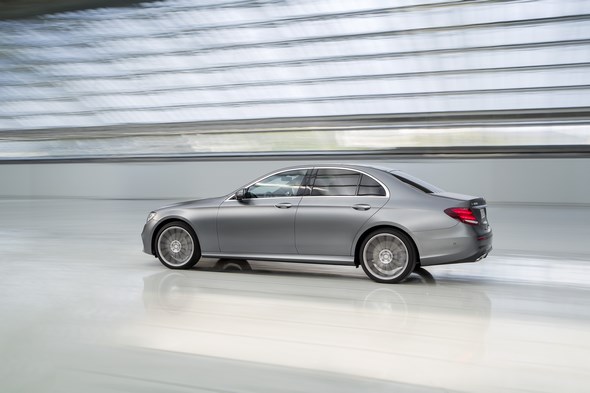
Sporty steering feel
All models of the E-Class family are equipped as standard with a sporty, electromechanical Direct-Steer system.
It combines speed-sensitive power assistance for the speed-sensitive steering with a steering ratio that varies according to the given steering angle.
The power assistance for the rack-and-pinion steering gear is controlled on demand.
Advantages of the electromechanical Direct-Steer system:
- improved agility thanks to more direct steering response
- comfortable handling and high level of steering comfort at all speeds
- savings potential, since energy is required only for steering
- enables the use of assistance systems, such as Active Park Assist
STEER CONTROL provides steering prompts in dangerous situations
The E-Class comes standard-equipped with the STEER CONTROL steering assistance function. It can help the driver to stabilise the vehicle in difficult handling situations.
To this end, the electronics determine in which direction the driver has to steer to defuse a critical situation, and introduces a corresponding steering torque into the steering that the driver feels clearly.
In this way STEER CONTROL provides the driver with prompts in which direction to steer in order to stabilise the vehicle.
If the vehicle oversteers, the steering wheel provides the driver with the prompt for correct countersteering until the vehicle is safely back on course.
Fade-resistant brakes for short stopping distances
The braking system with internally ventilated compound brake discs meets high standards in terms of stopping distance, response, fade resistance, directional stability and service life of the brake pads.
Single or 4-piston sliding callipers on the front and rear axles with brake discs whose size is dependent on the engine provide for rapid deceleration.
The E-Class comes as standard with ADAPTIVE BRAKE. It offers among other things
- Hill-Start Assist which prevents the vehicle from rolling backwards on hills and thus facilitates starting off
- a HOLD function which keeps the vehicle immobile without having to continuously press the brake pedal
- a brake-drying function which regularly wipes the moisture from the brake discs to make full braking power available at all times
- the priming function, which brings the brake pads into light contact with the disc if the driver suddenly releases the accelerator, and can thus shorten the stopping distance during subsequent braking.
Electric parking brake with Comfort Go
An electric parking brake is provided as standard. Pressing the control beneath the rotary light switch engages the electric parking brake; pulling releases it.
The driver can also use the automatic release function Comfort Go. It automatically releases the parking brake when driving off.
Additional functions of the brakes on the new E-Class:
- ESP® Dynamic Cornering Assist offers improved safety in critical cornering conditions. If the ESP® sensors detect an understeering tendency, the system performs specific braking intervention on the side of the vehicle which is on the inside of the bend. This gives rise to gentle rotary movement of the vehicle around the vertical axis.
The adaptive brake lights can warn vehicles following behind of heavy braking and shorten their reaction time.
Key topics: DYNAMIC SELECT
From “Comfort” to “Individual”. There are five different drive programs that allow the driver to influence the characteristics of their E-Class.
The driver chooses the desired driving experience with a switch in the lower control panel of the centre console.
Depending on the equipment level, the driver can choose from various preconfigured drive programs and one the driver can design personally to a large extent.
This influences the settings of various systems and components, such as the speed-sensitive power assistance for the steering, the shift points of the automatic transmission, the throttle response, the ECO start/stop function and the suspension.
Depending on the installed equipment, the following drive programs are available:
– Comfort
– ECO
– Sport
– Sport Plus
– Individual
“Comfort” mode is the most balanced drive program with corresponding suspension tuning and a consumption-optimised powertrain set-up. “Comfort” mode is activated after engine start initially – it is therefore the basic program so to speak.
The “ECO” drive program trims the vehicle for minimal fuel consumption. The driver can access ECO information in the multifunction display in order to adopt a more economical driving style.
With some engines, the vehicle is also capable of coasting when the driver releases the accelerator and lets the vehicle roll on overrun.
This decouples the engine from the powertrain and the associated friction losses. The vehicle uses its current kinetic energy for a certain distance and consequently glides on the road with almost no fuel consumption.
“Sport” mode is characterised by agility and driving pleasure with a sporty suspension tuning and direct accelerator pedal characteristics. The suspension is firm, but still offers good ride comfort.
In “Sport Plus” mode, the powertrain responds very directly and rapidly to dynamic load changes. In addition, optionally available multi-chamber AIR BODY CONTROL air suspension has even firmer tuning and approaches motor racing character. The ECO start/stop function is then deactivated.
“Individual” mode additionally offers the possibility to vary individual parameters for suspension (in case of air suspension), steering and powertrain.
They are complemented by additional adjustment options such as ECO start/stop, climate control and ECO Assist, depending on the vehicle.
On vehicles with manual transmission, an automatic double-declutching function is active when one of the sporty drive programs is selected.
It determines the target engine speed after a gear change and sets the appropriate engine speed automatically. This results in sporty driving characteristics you can feel, accompanied by enhanced comfort.
New assistance and safety systems
Next-generation driving assistance systems – Intelligent Drive next Level
Mercedes-Benz’s new assistance and safety systems enhance safety, comfort and driver assistance to new levels. In addition, the Stuttgart-based automobile manufacturer is thus taking an important further step on the road to autonomous driving.
The new Mercedes-Benz E-Class is the world’s first series production vehicle to be awarded a test licence for autonomous driving in the US state of Nevada.
This simply requires some software modifications while the standard hardware otherwise remains unchanged.
The engineers at Mercedes-Benz achieve the ideal combination of safety, comfort and stress relief by constantly further developing the safety components and driving assistance systems.
Integral Safety and Intelligent Drive are becoming increasingly intertwined, working in synergy in a cross-system concept. Its components can:
- assist and provide stress relief during normal driving
- detect dangers
- warn, assist and, if necessary, intervene in a timely manner
- consequently prevent accidents or reduce the severity of accidents
- activate protective measures such as the PRE-SAFE® components as a precaution in the event of danger and thus provide on-demand protection
The individual functions are linked to networked sensors and, therefore, a wealth of information about the vehicle and its surroundings – including an enhanced multi-purpose stereo camera behind the windscreen and new multi-stage radar sensors with adjustable range and opening angle around the vehicle plus tried-and-tested sensors such as ultrasonic sensors and the 360° camera.
The combined use of data from the sensors allows analysis of complex traffic situations, better detection of potential dangers on the road and, therefore, the ability to further enhance the capabilities of the safety and assistance systems.
To be able to offer optimal assistance also in wintry conditions, the latest-generation front radar is provided with so-called Radom heating, which effectively prevents the sensor being interfered with by snow.
Extensive assistance systems already as standard
The new E-Class comes as standard with Active Brake Assist. This further advanced system can provide effective aid in mitigating the severity of rear-end collisions or even in preventing them entirely.
To this end, the radar-based system constantly monitors the area of traffic in front of the vehicle, and can determine the distance and speed of the vehicles ahead.
If the following distance drops significantly below the safety threshold at speeds above 30 km/h, the system gives the driver a visual warning.
If, in the speed range between 7 and 250 km/h, it detects an acute risk of collision because of slower or stopped vehicles or, in the speed range between 7 and 80 km/h, because of stationary vehicles or crossing pedestrians, the system gives the driver an additional audible warning.
It also computes the brake pressure required to prevent a collision, if this is still possible. If, having been warned, the driver then steps on the brake pedal, the system is capable of boosting insufficient braking pressure in line with the needs of the situation.
In so doing, it makes the best possible use of the remaining distance in order to leave the vehicles behind room to brake.
If the driver fails to respond, Active Brake Assist can go one step further and, if the danger of collision persists, can perform autonomous braking for slower moving and stopping vehicles at speeds of up to 200 km/h to mitigate the severity of the accident and ideally prevent the collision entirely.
The system also brakes if stationary vehicles or crossing pedestrians are detected up to a speed of around 60 km/h, and can prevent collisions up to 50 km/h, depending on the situation.
ATTENTION ASSIST with adjustable sensitivity, which can warn the driver in timely manner of inattentiveness and drowsiness, is also included as standard. Crosswind Assist helps the driver by enabling them to clearly counteract disturbances such as strong gusts of wind by means of one-sided braking via ESP®.
DRIVE PILOT: Intelligent Drive next Level in the Driving Assistance package
The E-Class optionally offers additional assistance systems, the key innovations of which have been combined in a new Driving Assistance package.
The most important functions include semi-autonomous driving on motorways, country roads and even in the city as well as assistance when changing lanes on multi-lane roads, for example when overtaking.
Furthermore, it is capable in more and more situations of autonomously braking the vehicle if required and providing active assistance during evasive manoeuvres.
The centrepiece of the Driving Assistance package is DRIVE PILOT. This assistance system, as Distance Pilot DISTRONIC, automatically maintains the correct distance to vehicles in front by adjusting the car’s higher desired speed to that of a slower-moving vehicle ahead before accelerating back up to the desired speed once the way ahead is clear again.
With its Steering Pilot subfunction, it can also keep the E‑Class in lane up to speeds of 210 km/h. This can make life easier for the driver, who no longer needs to operate the brake or accelerator pedal during normal driving and also receives plenty of steering assistance – even on bends.
For orientation, DRIVE PILOT uses an enhanced multi-purpose stereo camera behind the windscreen and new radar sensors beneath the radiator grille and the rear bumper to detect road markings, the vehicle in front and also its surroundings.
Consequently, at speeds up to 130 km/h, it is not dependent on clearly visible lane markings as it can continue to intervene actively, like in a swarm, if the lines on the road are unclear, e.g. at roadworks, or even if there are no lines on the road at all.
If COMAND Online is fitted, DRIVE PILOT can provide enhanced comfort through the selectable Speed Limit Pilot subfunction.
By means of Distance Pilot DISTRONIC, it can autonomously adjust the vehicle’s speed in response to camera-detected speed limits, including gantries and signs at roadworks, or speed limits logged in the navigation system, such as 50 km/h in built-up areas or 100 km/h on country roads.
Despite active longitudinal and transverse guidance with enhanced steering assistance, Drive Pilot continues to be designed as a semi-automated assistance system in which the driver still needs to keep their hands on the steering wheel.
On the one hand, this is a technical necessity, while, on the other, it is a legal requirement. Intelligent hands-on detection provides a noticeably increased customer benefit while taking account of, for example, vehicle speed or road type and curvature.
This can take the pressure off the driver and provide assistance, especially in bumper-to-bumper or congested traffic, yet also on long journeys.
A contribution is also made by the intelligent and navigation-based design of the automatic restart after automatic stopping in stop-and-go traffic and traffic jams, such as on motorways up to 30 seconds.
Active Emergency Stop Assist can brake the vehicle to a standstill in its lane if it detects that the driver is permanently not taking control while on the move.
If there is no steering wheel movement over a longer period when the Steering Pilot is active, the system gives the driver a visual and audible prompt to place his/her hands on the wheel.
If, after being repeatedly warned, the driver does not react by steering, accelerating, braking or pressing a Touch Control button, the vehicle safely decelerates to a standstill in its lane and warns the traffic behind using the hazard warning flashers.
Lane-changing made easy
Impressive DRIVE PILOT innovations include an Active Lane-change Assistant, which assists the driver when changing lanes, e.g. when overtaking on multi-lane roads.
Once the driver has indicated to turn for at least two seconds, the Active Lane-change Assistant helps with steering the vehicle into the desired adjacent lane if it detects that the lane is unoccupied.
The driver merely monitors the change of lane. It is irrelevant whether the driver wants to move to the right-hand lane or change to the left lane for overtaking.
The criteria for operation of Active Lane Change Assist are:
- operation of the turn indicator for longer than two seconds
- the unoccupied zone detection system allows a lane change within three seconds
- Steering Pilot is activated
- vehicle travelling on a multi-lane, motorway-like road, detected via the navigation module integrated into COMAND Online
- speed between 80 and 180 km/h
A long-range radar system and the stereo camera monitor the area in front of the vehicle, while multi-mode radar sensors permanently check the area to the rear and sides.
Active lane change is aborted by the system if the sensor system detects an obstacle, no longer sees lane markings, the driver countersteers or Steering Pilot is switched off.
Automatic braking in an emergency
Further assistance is provided by an Active Brake Assist with a significantly extended functionality compared with the standard basic functions.
Its job is to warn the driver of imminent collisions, to optimally assist them during emergency braking and, if necessary, also to initiate autonomous braking.
Mercedes-Benz’s objective is thus to prevent collisions or at least to reduce their consequences.
Active Brake Assist likewise uses the radar sensors installed in the vehicle as well as the multi-purpose stereo camera. These enable it to detect whether the vehicle in front is slowing down, stopping or is stationary.
If the system detects a risk of collision and the driver fails to respond to a collision warning or is late responding, the system automatically initiates autonomous braking.
The cross-traffic function of Active Brake Assist also detects cross-traffic and pedestrians in the danger area in front of the vehicle. Also in these cases, Active Brake Assist first warns the driver if there is a risk of collision, providing assistance if the driver fails to brake hard enough.
If the driver fails to react, the system initiates braking automatically. If a pedestrian enters the danger area relatively late, the assistance system brakes simultaneously with the warning to allow the speed of the vehicle to be reduced faster.
Active Brake Assist is active in a speed range from 7 to 250 km/h for moving vehicles and can react to stationary vehicles between 7 and 100 km/h.
Under ideal conditions, it can thus prevent a collision with a stationary vehicle up to around 70 km/h and a collision with pedestrians up to a speed of around 65 km/h.
In end-of-tailback scenarios with no opportunity for evasive action, Active Brake Assist can automatically intervene even up to 130 km/h and, ideally, entirely prevent such especially dangerous rear-end collisions up to 100 km/h.
Depending on the situation, the cross-traffic function is capable of preventing collisions with crossing traffic in a speed range up to around 70 km/h or reducing the severity of the collision.
The system thus generally makes a significant contribution to preventing accidents or reducing their severity.
Active Brake Assist in the Driving Assistance package: Speed ranges
| Reaction | Speed range | Collision avoidance |
| in longitudinal traffic to… | ||
| …moving and stopped vehicles | 7 – 250 km/h | up to a relative speed of over 70 km/h |
| …stationary pedestrians
| 7 – about 70 km/h | 65 km/h |
| …stationary vehicles with room for evasive action | 7 – about 100 km/h | 70 km/h |
| …stationary vehicles without room for evasive action (end of tailback) | 7 – about 130 km/h | 100 km/h |
| to crossing… | ||
| … pedestrians
| 7 – about 70 km/h | 40 – 50 km/h depending on situation |
| … vehicles
| 7 – about 70 km/h | up to about 60 km/h depending on situation |
Safe evasive action
The intelligent innovations of the Driving Assistance package include Evasive Steering Assist. This can help the driver to avoid a pedestrian detected by the assistance system using the radar sensors and multi-purpose stereo camera.
If the driver initiates an evasive manoeuvre by turning the steering wheel, the system provides assistance by adding precisely calculated steering torque to support the movement of the steering wheel.
This torque helps the driver to avoid the pedestrian in a controlled manner and then makes it easier to straighten the vehicle up again so that it can drive past safely.
While the philosophy behind Evasive Steering Assist is to provide the driver with significant assistance, the initiative to take evasive action must come from the driver.
This is because, if evasive action were automatic, a previously inattentive driver might be so surprised by the spontaneous movement of the steering wheel that they might react incorrectly and, for example, attempt intuitively to steer in the opposite direction.
Proven assistance systems
The intelligent assistance systems in the new Driving Assistance package also include, for example, proven systems that have been further developed in terms of their mode of operation and the sensors they use.
Active Lane Keeping Assist can help stop the driver from unintentionally changing lane, this being done by corrective one-sided application of the brakes in the case of solid or broken lines and risk of collision, e.g. with oncoming traffic or fast overtaking vehicles.
Active Blind Spot Assist can now also warn of the risk of a lateral collision in typical urban traffic at low speeds and, in addition, as before, correctively intervene at the last moment to prevent a lateral collision, e.g. with cyclists, at speeds above 30 km/h and activate the PRE-SAFE® belt tensioners.
PRE-SAFE® PLUS can protect against collisions with following traffic and their impacts on the occupants by warning the vehicle behind, activating the PRE-SAFE® belt tensioners and, if stationary, by applying the brakes to stop the vehicle from being moved.
Modular range
The E-Class offers a modular range of driving assistance systems. In addition to the already extensive standard equipment specification, optional extras, as far as the Driving Assistance package, provide the possibility to individually configure the vehicle.
A simple Distance Pilot DISTRONIC for comfortable longitudinal control is optionally available. Already in its purely advisory version, Blind Spot Assist is capable at low speeds of warning of vehicles, including cyclists, in the danger area.
The Lane Tracking package adds an Active Lane Keeping Assist, which, already in the basic variant, is capable of warning against unintentional lane departure by vibrating the steering wheel and which, if the driver crosses a solid line, can correctively intervene by means of one-sided application of the brakes.
The functionality of Traffic Sign Assist has been extended to include, for example, a warning about people near zebra crossings and an extended wrong-way warning function, which is now also capable of warning about driving the wrong way into a one-way street or roundabout.
In addition, the detection of stop signs has been coupled with the ECO start/stop function and is suitably taken into consideration by the latter.
Technology with future potential
To allow autonomous driving functions to be tested, test vehicles previously had to be elaborately equipped with special hardware and software.
This included additional sensors, modified steering and an adapted ESP®. That is no longer the case with the new Mercedes-Benz E-Class.
The series production vehicle is already extensively equipped with intelligent technology. This means that, for testing purposes, it is necessary merely to make some minor software modifications to the DRIVE PILOT control unit, the so-called “Intelligent Drive Controller”.
More specifically, changes were made only to Steering Pilot and Speed Limit Pilot. For example, Hands-On Detection was shut down and the steering dynamics were significantly increased.
The new Mercedes-Benz E-Class is thus the world’s first series production vehicle to be awarded a test licence for autonomous driving in the US state of Nevada. It also caused a sensation at this year’s CES.
Remote Parking Pilot
Parking – no problem
To make parking easier, the E-Class is optionally available with three variants of Parking Assist: Parking Pilot – optionally with 360o camera – as well as the new Remote Parking Pilot.
The Parking Pilot with PARKTRONIC Parking Assist and reversing camera makes it easier to find and choose a parking space and also to enter or leave parallel or end-on parking spaces.
Both forwards and backwards into end-on parking spaces. It manoeuvres the vehicle automatically into the selected parking space and can steer and brake if an obstacle is detected.
If the vehicle is equipped with automatic transmission, the speed is controlled automatically and gear changes are also automatic.
If Parking Pilot is not used for parking or leaving a parking space, PARKTRONIC will monitor the front and rear areas as well as, if possible, the sides of the vehicle. If it detects a risk of collision, it warns the driver.
If Blind Spot Assist is installed, and if crossing traffic is detected behind the vehicle, the Rear Cross Traffic Alert is capable of giving a warning or automatically initiating braking and providing the driver with an audible warning.
With Parking Pilot with 360° camera, all-round vision is made possible by the reversing cameras and three other additional cameras. Observation of the areas to the side and directly in front of the vehicle thus helps during parking and manoeuvring.
The information from Parking Pilot and the cameras is graphically presented in full HD on the display in the vehicle.
Remotely controlled parking by smartphone app
Entering or leaving a tight parking space or parking in the garage can be an ordeal. Such situations are made easier by Mercedes-Benz with a newly available system that makes it possible for the first time to enter or exit a parking space from outside the vehicle: Remote Parking Pilot is enabled by smartphone over a Bluetooth® connection.
The app specifically developed for this purpose by Mercedes-Benz can be subscribed to at the relevant app store and activated via the Mercedes me portal.
Also beneficial for people with restricted mobility, the Remote Parking Pilot allows the vehicle to be remotely manoeuvred into a position that makes it easier to get into or out of the car.
Parents also benefit, as they no longer need to leave young children waiting near the parking spot or at the side of the road while they manoeuvre out of a tight parking space.
With the Remote Parking Pilot, the family can wait safely until the vehicle is in a position that allows them to get in or out safely.
To use this convenience-enhancing system, the driver and their smartphone must be within around three metres of the vehicle. Operation is via a smartphone app (Android, iOS) available for download from the various app stores.
The driver must unlock the vehicle before it is moved out of the parking space. He or she can then establish a connection with their already authorised smartphone and fetch the vehicle out of the parking space.
Prior to parking, the driver selects one of the relevant parking scenarios – such as parallel or perpendicular parking, left or right, forward or reverse.
The vehicle can then be moved by remote control. The parking scenario is enacted automatically – including steering, braking and direction changes – as long as the driver provides a continuous confirmation gesture on the smartphone.
The driver monitors the process from outside the vehicle and still has complete responsibility for their vehicle during the entire parking process.
In addition to the parking scenarios, there is an Exploration mode, which allows the vehicle to be manoeuvred up to fifteen metres forward or backward, avoiding and not touching any detected obstacles as it moves – when driving into a garage, for example.
The Remote Parking Pilot can only operate in conjunction with Parking Pilot PARKTRONIC’s ultrasonic sensors.
The system newly developed by Mercedes-Benz is available in conjunction with the optional extras Parking Pilot with 360° camera, KEYLESS GO, which monitors the distance between driver and vehicle, and automatic transmission.
Key topics: Car-to-X communication
Car-to-X technology allows information to be sent to other vehicles over a long distance in order to give them early warning, for example, of a hazardous situation.
Mercedes-Benz is the first manufacturer to offer Car-to-X communication in standard production vehicles.
Accident site around the next bend? A sudden traffic jam at a roadworks? These nasty surprises are factored out of the equation if the approaching motorist is given an accurate warning in plenty of time.
Vehicles will be able to do this in future by warning other road users automatically once they themselves have registered a hazard.
This is the principle of Car-to-X communication, which Mercedes-Benz has co-initiated, becoming the world’s first car manufacturer to introduce it in series production vehicles.
Car-to-X technology significantly extends the previous range of vehicle sensors, such as radar or camera systems.
It allows information on dangerous situations automatically detected in the vehicle or manually reported by the driver to be sent to other vehicles, making it possible to “see” around corners or through obstacles.
Consequently, information on potential hazards on the road can be sent to drivers at an early stage so that they can prepare for them and avoid critical situations altogether – such as those caused by suddenly changing weather conditions or stationary recovery vehicles at the side of the road.
As well as being able to receive hazard warnings, every vehicle equipped with Car-to-X technology can also send such warnings to other road users.
As a result of seamless integration into the existing vehicle systems, Mercedes-Benz passenger cars are able to automatically detect a variety of sources of danger, such as a breakdown or heavy rain.
The driver does not need to do anything.
For Car-to-X communication, Mercedes-Benz uses the vehicle’s integrated mobile-phone technology, as, thanks to its widespread use, it can unleash the potential of Car-to-X technology in the shortest time.
In the Daimler Vehicle Backend server, the data are aggregated, checked for plausibility and forwarded to other similarly equipped vehicles in the relevant vicinity.
The system is designed to use third-party information, too. Since autumn 2015, for example, the German state of Hesse has provided information on mobile roadworks. The inclusion of additional data sources is in preparation.
Car-to-X communication operates in the background and does not distract the driver’s attention from the road. It provides the driver with early and accurate information in safety-critical situations.
Car-to-X technology can therefore be seamlessly integrated into the “Mercedes-Benz Intelligent Drive” strategy.
By becoming the world’s first manufacturer to introduce Car-to-X technology in series production vehicles, Mercedes-Benz is once again reaffirming its role as a safety pioneer, and demonstrating that its engineers are continuing to work consistently to bring to the roads innovations that can be used not only by our customers but also by other road users.
Passive safety
Safe with intelligent systems
True to Mercedes-Benz tradition, the new E-Class sets standards in terms of passive safety, too. For example, the PRE-SAFE® protection concept has now been upgraded into all-round monitoring.
Mercedes-Benz has for years been protecting car occupants with its PRE-SAFE® concept in a host of accident situations.
The concept includes various measures to move the occupants into the best possible position prior to an imminent impact.
Based on findings from its own accident research, Mercedes-Benz has continuously developed this system further and is now incorporating innovations to upgrade it into an all-round monitoring system.
For this purpose, the new E-class is equipped for the first time with the new subsystem PRE-SAFE® Impulse Side.
Together with the familiar PRE-SAFE® protection concepts for frontal and rear collisions, it allows a kind of virtual crumple zone that extends all around the vehicle – PRE-SAFE® 360°.
As only a limited crumple zone is available in the case of a side impact, even before the crash, PRE-SAFE® Impulse Side can move the affected driver or front passenger as far as possible away from the acute danger zone as soon as the system detects that a side collision is immediately imminent.
For this purpose, air chambers in the side bolsters of the front seat backrest are inflated in fractions of a second.
This impulse can move the occupant to the side, away from the acute danger area and towards the centre of the vehicle, thus increasing the distance between occupant and door.
At the same time, the impulse is imparted moderately to the occupant, lessening the forces acting on them during the side impact. This can reduce the forces to which the occupant’s rib cage is subjected during a side collision.
The system is optionally available for the first row of seats as part of the Driving Assistance package Plus.
PRE-SAFE® Sound – protecting the ears against the noise of a crash
With its new PRE-SAFE® Sound, Mercedes-Benz is for the first time making use of a natural reflex to prepare the occupants’ ears for the loud noise normally associated with an accident.
The system is based on the fact that the so-called stapedius muscle in our ears reacts to loud noises by contracting in a reflex action.
The contraction of this tiny muscle briefly changes the link between the eardrum and the inner ear, providing greater protection against high sound pressures.
Mercedes-Benz uses this natural reflex as biomechanical ear protection for PRE‑SAFE® Sound. This is because an accident can cause noise to which some people have a sensitive reaction. PRE-SAFE® Sound therefore emits a short noise signal through the vehicle’s sound system if the risk of a collision is detected.
This signal can trigger the stapedius reflex, which prepares the ears for the noise. And thus lessens the risk of hearing discomfort or damage.
Even more intervention scenarios
So far, the PRE-SAFE® system has reacted as soon as it detects an imminent collision or other hazard – such as because of a shock reaction on the part of the driver, e.g. emergency braking or critical steering wheel movements.
Or because of unusual vehicle behaviour, such as over/understeer or substantial intervention by assistance systems.
For added safety, the system now reacts to even more intervention scenarios. These include a detected fast switch by the driver from accelerator to brake pedal (shock reaction), critical steering wheel movements, now also at low speeds, a clearly autonomous course correction by Crosswind Assist and a detected, immediately imminent side collision.
Beltbag – clever cross between belt and airbag
Three-point seat belts with pyrotechnical belt tensioners and belt force limiters are installed for driver, front passenger and passengers on the outer rear seats.
The centre seat of the second row is equipped with a standard 3-point belt system. For the first time, beltbags are optionally available for the outer rear passengers in the E-Class.
The beltbag is a combination of seat belt and airbag components – an inflatable seat belt that is capable of widening its belt strap and thus further reducing the risk of injury in the event of an accident. It is used in exactly the same way as a conventional seat belt.
In the event of a serious frontal collision, a gas generator on the belt’s end fitting inflates the belt strap to over twice its normal width.
This enlarges the belt strap area in the upper body region so that the force is distributed more widely than is the case with a conventional belt.
In addition, a host of airbags provides occupant protection in an accident.
These include:
- driver and front passenger airbags
- kneebag for the driver to protect the knees and stabilise the upper body, which positively influences occupant movement in an accident.
- a windowbag in the roof area between A, B and C-pillars for the head area of driver, front passenger and passengers in the outer rear seats
- combined thorax/pelvis sidebags for driver and front passenger, which are able to provide additional protection in the event of a side impact, as well as optionally available sidebags for the outer rear seats
Systematic pedestrian protection
The following measures are implemented for pedestrian protection:
- Active Brake Assist warns if pedestrians are detected in the danger area by the multi-purpose stereo camera and, if necessary, initiates autonomous braking if the driver fails to react to the warning from the system.
- Specific flexibility in the frontal region as well as an active bonnet, which can be raised by 80 mm when an impact is detected, thus creating additional deformation space during an impact.
In the event of an accident
After an accident has occurred, various measures dependent on accident type and severity can mitigate the consequences and make fast rescue possible. These include:
- automatic activation of hazard warning lights
- emergency shut-off of engine and fuel pump
- emergency door unlocking
- emergency call
- disconnection of the 12 V starter cable
- high-voltage switch-off
- emergency switch-off of the air conditioning system
- emergency interior lighting
- ventilation by slightly lowering the front windows by a few centimetres
- exit assistance for the driver by lowering the steering column
Mercedes-Benz emergency call for fastest possible assistance
The E-Class is equipped with Mercedes-Benz emergency call. An emergency call can be made automatically or manually.
It is automatically activated as soon as an accident of a certain severity is detected and restraint systems have been triggered.
The position data of the vehicle, the chassis number, Mercedes-Benz contact coding, an indicator for automatic or manual triggering, time stamp, language setting of the vehicle and estimated number of occupants are sent to the Mercedes-Benz emergency call centre, which then establishes a voice connection with the vehicle.
If there is no response, it immediately alerts the nearest rescue service.
Guidelines for Rescue Services with important information for rescuers
To enable rescuers to work quickly and safely, Mercedes-Benz provides a rescue card for the E-Class in various languages that can be downloaded free of charge.
The new E-Class is also equipped with QR code stickers – a small but effective measure with which Mercedes-Benz makes rescuing accident victims faster and safer.
The QR code can be read with smartphones and tablet computers and sends a rescue card for the vehicle model to the display of the rescuers. This card contains all the information needed to rescue casualties quickly.
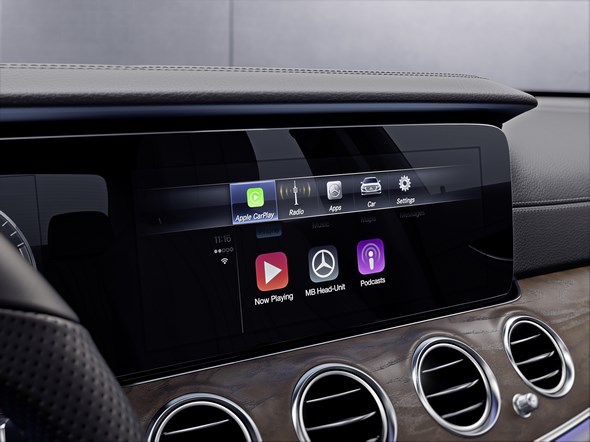
Infotainment
Very well entertained and connected
An all-new infotainment generation is making its debut in the E-Class equipped with COMAND Online. One of many highlights is the wireless integration of smartphones.
Mercedes-Benz is ushering in a new era of digitalisation and networking in the new E-Class. This includes effortless integration of the smartphone into the vehicle’s infotainment system by means of capacitive aerial coupling and wireless charging.
This means that mobile phones can be charged wirelessly and at the same time connected to the vehicle’s exterior aerial. This dispenses with the need to find a plug and connect a cable.
Simply place the device on the charging pad at the front of the centre console to connect the smartphone by Near Field Communication (NFC) with the multimedia system.
The inductive charging pad has the dimensions 153 x 90 millimetres and is suitable for mobile devices that support the Qi standard.
There is another advantage: using Near Field Communication, the customer’s smartphone becomes the digital vehicle key with which the car can be locked and unlocked as well as started.
The wireless charging system functions with all mobile devices which support or can be upgraded to support the Qi standard. The charging pad is integrated into the quick stowage tray at the front of the centre console.
A connection is established between head unit and mobile phone via Near Field Communication (NFC) by touching the “NFC” logo. Phone calls can then be made via the Bluetooth® hands-free system.

Smartphone integration via Apple CarPlay® and Android Auto
If the vehicle is equipped with COMAND Online, it is possible to use Apple’s smartphone-based infotainment system CarPlay® as well as Google’s Android Auto™.
If a corresponding smartphone is connected by USB, the customer can, if desired, switch to the CarPlay® or Android Auto interface.
Internet and diverse data sources even in the basic version
In addition to COMAND Online, the Audio 20 USB/GPS infotainment systems are available. Like COMAND Online, they come with a Bluetooth® hands-free system and also have internet capability with a Bluetooth®-capable mobile phone with mobile phone card and data option.
This allows internet surfing without restriction when the vehicle is stationary. With COMAND Online, the Mercedes-Benz apps can also be used while driving.
Audio and video playback is possible from various sources with all three variants. For example via Bluetooth® or USB stick. COMAND Online also offers integrated hotspot functionality.
It allows passengers in all seats to connect different WiFi-capable devices, such as laptop or tablet computers, to the internet.
Modern-style navigation
The Audio 20 GPS offers entry-level navigation on an SD card. It can be optionally supplemented with the Garmin® MAP PILOT navigation system.
COMAND Online with its own fast 3D hard-drive navigation, topographical map display, photo-realistic 3D buildings and 3D map rotations makes for a special sensory experience.
The system presents its content interactively and its features include an animated compass.
Up to the minute: Live Traffic Information
Whereas the familiar Live Traffic Information was previously reserved for COMAND Online, the new E-Class offers this function with the Audio 20 GPS with GARMIN MAP PILOT SYSTEM.
Live Traffic Information allows the reception of up-to-the-minute and accurate traffic information, which is updated by the system every two minutes on the GARMIN MAP PILOT SYSTEM or COMAND Online.
Taking the current vehicle location into account when requesting traffic information also ensures that the enquiring vehicles receive all the traffic information of relevance to them.
The received traffic information is based on so-called “Floating Car Data” ‒ the key technology for precise acquisition of traffic data.
3D sound with concert hall experience
The Frontbass system in the new E-Class delivers a special listening experience as standard. It uses the space in the cross-member and side member of the body structure as a resonance chamber for the bass speakers.
The standard audio system has an output of 4 x 25 watts and seven speakers. The Burmester® surround sound system is optionally available for superior listening pleasure.
It drives 14 speakers with a 9‑channel DSP amplifier and a total system power of 640 watts. All the speakers are additionally optimised for performance with the premium sound system.
Alternatively, audiophiles can opt for the new Burmester® high-end 3D surround sound system. This treats the occupants to a listening experience reminiscent of the acoustics in a concert hall, for this second-generation sound system additionally uses four roof speakers – two in the front and two in the rear area of the roof.
The effect: reflections, which come off the ceiling in a concert hall, are incorporated in the same authentic manner into the sound design of the E-Class.
By contrast, other 3D sound systems dispense with roof speakers and use appropriate algorithms to simulate a 3D sound.
Apart from 3D Surround, four other preset sound modes can be selected to suit every taste and audio source:
- Pure: audiophile sound reproduction with no additional effects, for unadulterated musical enjoyment
- Live: appealing, dynamic sound background akin to live music
- Easy listening: milder sound background for relaxed listening over longer periods
- Surround: virtual surround sound
- 3D Surround: three-dimensional listening experience provided by the roof speakers
The technical specification of the Burmester® high-end 3D surround sound system employs 23 high-end speakers with diaphragms of glass-fibre fabric for high level stability, low weight and higher power.
Specially developed for their task, the roof speakers are extremely small and flat and radiate sound in all directions.
The speaker package includes a 25-litre bass box with its own 400 W amplifier in the boot, two woofer/mid-range speakers in the front doors as well as seven mid-range speakers and ring radiator tweeters of aluminium for precise sound resolution.
The tweeters in the front mirror triangle not only fulfil their sound function, but are also design objects: when the sound system is turned on, they revolve out from the mirror triangle into the optimal radiation position.
The ambience lighting also transforms them into a visual highlight. Two amplifiers with a total power of 1450 W drive all the speakers individually via separate channels and active crossovers.
A combination of digital and analogue amplifiers contributes to the special listening experience. The analogue technology ensures a warm, round and full sound, while the digital technology uses a separate power supply to produce high peaks in order to enable a high dynamic between the quietest and loudest tones.
As in the S-Class, the sound can be optimally adjusted for every seat position using the so-called VIP setting.

Connected to the car via internet
Under the name “Mercedes me connect “, Mercedes-Benz offers an extensive package of free standard services via a communications module integrated into the vehicle.
This module also makes it possible to use the fee-based Remote Online services. The range of services is being expanded continuously.
The free standard services include automatic emergency call (eCall), Accident Recovery, Breakdown Management and Maintenance Management.
The optional Remote Online services allow the driver to connect to their vehicle from anywhere and at any time, to access vehicle information and to remotely activate a variety of functions.
The range of functions includes vehicle locating, remote door locking/unlocking and programming of the auxiliary heating.
This works both with the Mercedes me app (available for iOS and Android) and via the Mercedes me portal (www.mercedes.me).

Body
Lighter and stiffer
Less weight, excellent stiffness for superb handling coupled with optimum noise and vibration characteristics as well as high crash safety – the bodyshell of the new E-Class provides an innovative base which also facilitates new fuel consumption benchmark figures.
Thanks to intelligent lightweight construction, the body is some 70 kilograms lighter than a conventional steel body.
To achieve this, sheet steel and die-cast aluminium are used as materials for most of the bodyshell. The front wings, bonnet, boot lid, and large sections of the front and rear ends are made of sheet or cast aluminium.
For example, to increase the local introduction stiffness, the damper brackets at the front are no longer of the usual sheet steel, but of cast aluminium.
It was possible to integrate and merge in a single pressure die-cast part several parts that are made up of several steel components in conventional designs.
In addition, there was a significant increase in the proportion of ultra-high-strength steel compared with the previous model.
This lightweight design reduces fuel consumption and makes for perceptibly sporty and agile vehicle handling.
Percentage weight of materials at a glance
| New E-Class | Previous model | |
| Aluminium (sheet and cast) % | 16 | 5 |
| Ultra-high-strength sheet steel % | 6 | 3 |
Other design details include larger cross-sections as well as precisely calculated stabilising beads in the floor and bulkhead.
High-strength adhesives are used extensively to firmly bond the parts, which, in turn, helps increase the stiffness of the bodyshell.
Body and bodyshell set a new benchmark in terms of overall vehicle stiffness. As a result, the ambitious goals for driving dynamics and noise level have been exceeded.
Safety takes precedence
The body has been designed for high crash safety. The saloon not only meets all current national and international laws, but also all rating requirements as well as the more stringent internal Mercedes-Benz safety requirements, which are based on what actually happens in real-life accidents.
A high-strength safety passenger compartment forms the core of this concept. It consists primarily of high-strength and ultra-high-strength sheet steel and panels with graduated wall thicknesses designed to withstand specific local stresses.
Many segments consist of hot-formed steels, which become very hard as a result of this production process.
The high-strength passenger cell is surrounded by specifically calculated deformation zones which have been extensively field-tested.
Thanks to optimised dissipation paths and a combination of aluminium die-cast parts and ultra-high-strength materials, this set-up achieves outstanding crash test results (e.g. Euro NCAP and U.S. NCAP) and guarantees high occupant safety.
An important contribution to pedestrian safety is the active bonnet in the new E‑Class. The technical basis is a comprehensive sensor system in conjunction with intelligent algorithms in the airbag control unit, which decides when to trigger.
After the pyrotechnical actuators have fired, the bonnet lifts by a noticeable amount at the hinge in fractions of a second to create additional space between the bonnet and the components in the engine compartment.
State-of-the-art headlamps
The new E-Class comes as standard with standard halogen headlamps. These incorporate an energy-saving LED daytime running lamp.
Alternatively, a static LED High Performance headlamp as well as an innovative MULTIBEAM LED headlamp system with Intelligent Light System and adaptive Highbeam Assist Plus are available.
Key topics: MULTIBEAM LED headlamps
The E-Class with enhanced MULTIBEAM LED headlamps opens up new dimensions in headlamp technology.
Each headlamp is now equipped with 84 individually activated high-performance LEDs rather than 24, which means that they are exceptionally bright and precise, and automatically illuminate the road surface with a previously unsurpassed, precision-controlled distribution of light – without dazzling other road users.
Advances in lighting technology are a tradition at Mercedes-Benz: around 500 LEDs attended to all the lighting functions on a car for the first time on the S-Class in 2013. In 2014 Mercedes-Benz unveiled new MULTIBEAM LED headlamps with precision LED grid modules in the CLS, to make night-time traffic safer for all road users.
The statistics show just how important such precision lights are: at night-time, the risk of accidents increases drastically.
At night on rural roads there are basically around five times as many accidents with serious consequences as during the day.
Although night-time driving on this category of road only accounts for 20 percent of total mileage, this is when and where 40 percent all of all fatal accidents occur (source: BASt, German Federal Office for Roads and Traffic).
Unlike the MULTIBEAM LED headlamps on the CLS, which each feature 24 individual high-performance LEDs, the next generation on the new E-Class uses a newly developed, high-resolution precision LED module as a grid light source, fitted with 84 high-performance LED chips.
This is able to react even more dynamically, and the light illuminating the road is high-resolution and even more precise. In addition, the “cornering light” function can be implemented without mechanical actuators.
Each one of these LEDs can be individually electronically controlled. “Gridding” the light in this way allows the light distribution from the right and left headlamps to be controlled entirely separately and adapted to the traffic conditions with a high level of dynamism.
This enables the individual areas of the road surface to be illuminated in a very specific manner.
When it comes to the number of pixels, the same is true of an LED headlamp as of a monitor: the higher the number of individually controllable pixels, the higher the resolution and the more detailed the image.
A high number of pixels also allows greater dynamism in the display. In terms of perception, this leads to a clear increase in precision and brilliance.
With 84 LEDs per precision module, the headlamps on the new E-Class allow the resolution of the light pattern to be increased by a factor of around 3.5.
As a result, other road users can be better protected against dazzling, and back-glare can be more effectively avoided.
This new dimension of precision when it comes to light distribution allows longer use to be made of the partial main-beam lights, increasing safety.
The driver also benefits from improved illumination of the road. Compared with the systems prevalent on the market today, the MULTIBEAM LED headlamps have up to 2.5 times the partial high-beam light output.
Blue fascination
The 2nd-generation MULTIBEAM headlamps are instantly recognisable. They provide new, visual highlights with passively illuminated, blue light surfaces.
These outline the hallmark E-Class “torch effect” of the daytime running lamps and side lights and, even when low beam or high beam is switched on, create a blue setting for a characteristic look.
New safety-enhancing functions
As a result of the freely configurable high-resolution light distribution, it is possible for the first time in the new E-Class to implement all high and low-beam functions of the Intelligent Light System in all-digital mode and without any mechanical actuators.
As a world first, the dynamic cornering light function is all-electronic. In addition, a wealth of new adaptive light functions are possible, which will make night-time driving safer for both the driver and other road users.
The newly developed adverse weather light function reduces reflections on the oncoming lane when it is raining by specifically dimming individual LEDs and actively helps prevent indirect dazzling of oncoming traffic.
The city light function provides the driver with particularly wide light distribution when driving at low speeds and on lit roads in built-up areas, brightly illuminating difficult-to-see pavements and danger zones.
Data from the navigation system is not only used for the roundabout light function, familiar from the CLS, but can also now be used to detect junctions and motorways and to adapt the light distribution automatically to suit these.
Adaptive Highbeam Assist PLUS has also been optimised: thanks to a larger number of pixels, the dark areas in the light distribution are more precise and dynamic than ever before in partial main-beam mode, and the main beam can be used for longer than before.
A camera on the windscreen supplies the system with the information it needs about the constantly changing traffic situation and is also used by other assistance functions.
Four control units per vehicle calculate the ideal light pattern 100 times per second and activate all 84 high-performance LEDs in each precision grid module individually.
The added safety provided by the MULTIBEAM LED technology becomes apparent above all in real traffic situations: in contrast to purely static high-beam systems, some of which have long ranges, MULTIBEAM LED also supports the driver when there are other vehicles in the field illuminated by the headlamps.
Because it specifically masks these out of its light distribution in fractions of a second, it is possible to drive with main beam switched on at all times.
This assures the driver of the best possible light performance at all times, without dazzling other road users.
Advantage of LEDs
The LED technology used for the headlamps offers further advantages: by way of example, the light from the bright LED headlamps is almost the same colour as daylight and therefore in line with normal human perception patterns.
Studies have shown that the closer the colour of artificial light is to daylight, the less the strain on the eyes. With a colour temperature of 5500 kelvin, LED light is closer to daylight (6500 K) than xenon headlamps (4200 K).
The high-performance LEDs in the headlamps also help to increase efficiency thanks to their high lumen output/wattage and are designed to last for the entire vehicle lifetime.
Safety benefits of LEDs in tail lights, too: brightness rather than glare
The new E-Class, too, will launch with tail lights that feature multi-level functionality, still a unique feature of Mercedes-Benz.
The brake lights and indicators are operated with varying light intensity, depending on the driving situation and ambient lighting (day/night).
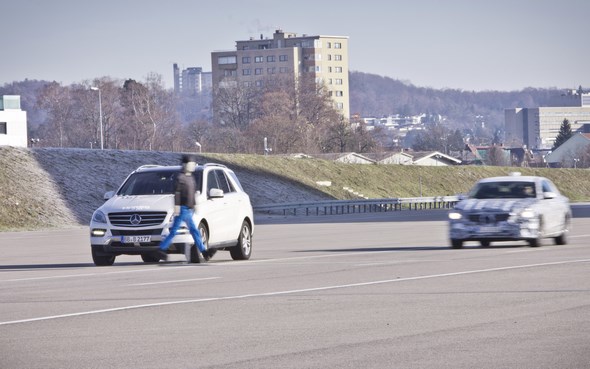 If the Mercedes driver presses the brake pedal while stopped at traffic lights at night, for instance, the brightness of the brake lights will be automatically dimmed to avoid dazzling anyone behind.
If the Mercedes driver presses the brake pedal while stopped at traffic lights at night, for instance, the brightness of the brake lights will be automatically dimmed to avoid dazzling anyone behind.
It goes without saying that the lights still comply with all statutory requirements.
During the development phase, light experts at Mercedes-Benz carried out experiments at a testing ground, simulating real traffic situations.
The tail lights of the test vehicle were operated with varying intensity at different times of the day and under different light conditions, and the brightness and density of the light were measured.
With the aid of these values, glare at a specified minimum light intensity was reduced to the desired level.
Optionally available rear lights provide an additional highlight reminiscent of stardust, the Milky Way or the glow of a jet engine.
This “stardust” effect is created by an innovative reflector technology with a specially designed surface structure for the tail light and ensures a brilliant appearance. The optionally available rear light uses all-LED technology.




